In real estate, it matters a lot what people think about your agency. We can all agree that, as businesses, we crave trust and loyalty from our customers. If these two traits are absent, success becomes much harder (if not impossible) to achieve.
Related: Real estate marketing guide & ideas
The consistency of your brand has a huge impact on what people think. If your real estate brand is constantly changing, people will see you as less honest and reliable. On the other hand, if your message is consistent and validates your brand promise, it’s easier to build trust with your audience and earn their loyalty.
So, where can you deliver this messaging? In real estate, there are several areas where you can achieve remarkable brand consistency. Here are five of them.
Property listings
Great property listings contain three elements: property data, description and photographs. Of these, the description accounts for the largest portion of the listing, so focus your efforts there. Write compelling descriptions complete with all the features and benefits anyone looking for that specific property would find valuable.
Each potential buyer has a particular set of expectations. If the description you write helps them evaluate the property against their expectations and make better decisions, that will set the foundation for a solid relationship with your real estate brand.
As you write, remember that brand assets like tone, voice, taglines & logos should always be consistent, and that your message should align with your brand’s goals as well as the needs of your target audience.
Neighborhood & home search
If you want to be the go-to real estate agency in your area, show your audience that you really know and understand the communities you serve.
Sometimes you’ll encounter potential home buyers who aren’t familiar with the area, and if you can become a dependable local resource for them, you’ll develop a trusting and loyal relationship.
Focus on what makes the neighborhood special and what homeowners usually consider when looking for a property. This could mean schools, hospitals, weather, culture, parks and local attractions. You could also request testimonials from people who live in the area and include them in your listings. Videos and photographs are great additions, too.
Responsive web design
Build consistency into how your website functions across all devices, from phones and tablets to computers. Regardless of how a person accesses your real estate website, the user experience should be cohesive and well-designed. If it’s not, your visitors could easily turn away.
Remember, your brand largely depends on how people view your business. If they can’t comfortably access your website on their tablet or mobile device, they will likely feel impatient and turn to your competition to get their needs met.
Without responsive design, visitors will wonder whether your real estate brand is old-fashioned, and they might assume you’re not up-to-date with new trends and technology. Instead, keep those visitors coming back by offering a consistent, excellent browsing experience tailored to their needs.
Pictures & video
We live in a visual culture. In real estate, this is supported by the fact that 83% of home buyers expect to view pictures of available properties, whether it’s through print marketing, a website or social media. [![]() ]
]
Your brand stands to benefit if your visuals come across well and emphasize points of interest. Photos should always be high quality and leave a strong, positive impression. Spend a little time learning best practices for real estate photography before hiring a photographer or taking photos yourself.
Video has evolved with trends like personalization and technology like interactive videos, 360 videos, and VR videos that are more immersive for the viewer. For maximum visibility, you can share them across multiple channels: your website, online video platforms, and social media. For example, here’s a video we made with the help of a few real estate clients:
Social media profiles
There’s no doubt that a huge portion of realtors (91%, in fact) use social media—and so do your potential buyers. Your social media presence will inevitably have a significant impact on how your brand is perceived.
The logos, colors & visuals used on your social media profiles will affect how your audience perceives and remembers you. Tone and voice are important, too—conflicting messages will confuse customers and dilute your brand.
Of course, authenticity and humanity are also important to social media users. Make it your goal to give your brand a unique identity and personality that your followers can easily relate to. This will help you cultivate a loyal following and stand out from your competitors.
Key takeaway
Brand consistency is about getting your audience to trust you. The five areas covered here hold a great amount of power to keep your brand consistent. Each plays a special role in getting clients to call you, to pay attention to your message, and to look forward to working with you again.
Your brand matters. Learn how to protect and elevate your real estate brand in this branding essentials guidebook.
When shopping for a new home, real estate buyers want to know what it’s really like to stroll through the kitchen, stand on the balcony or lounge in the backyard. Since they’ll be investing years in a house or apartment, they want to imagine themselves in the space before they contact a real estate agent. Next to physically being there, listing videos provide the best experience for persuading buyers that their dream home is just a click away.
Related: Guide to an effective real estate listing marketing strategy
Although listing videos are big in real estate marketing, few real estate agents actually take advantage of the power of video to immerse and move buyers to purchase. The National Association of Realtors found that 85% of buyers & sellers prefer to work with a real estate agent who offers video marketing… but only 15% of agents actually use video to market their listings.
High demand and low supply gives those real estate agents willing to invest in video an edge in finding potential buyers. With a little practice, it’s easy to create real estate listing videos that’ll get your properties moving.
Planning shots in a listing video
You should already be familiar with the property, so make a shot list of all the rooms, outbuildings, porches, pergolas, and other pertinent features you want to capture beforehand. Focus on the interior first. Plan your shots like you would plan an actual walkthrough with a prospective buyer. Start with the entryway, then move into the living room or the next logical place. This will make the final edit feel natural as you take the buyer from shot to shot.
As a general rule, you’ll want your video to contain around 75% interior shots and 25% exterior. You don’t need to show every nook and cranny of the property. Concentrate on the most visually appealing and emotionally moving parts—the selling points.
One must-have is the “hero shot” that will be the climax of the story you’re telling. It may be a beautiful vaulted ceiling, an indoor pool or a breathtaking mountain view from the backyard. Whatever it is, your hero shot should be the star of your listing video, and you’ll want to place it where it has the biggest emotional effect.
Pro tip: Take still photos from all the vantage points you use to shoot video. Use the images to create a storyboard of your video. The images will work as reminders and guides for the best angles and spots to put your camera. You can import all of your images into a storyboard template and organize them how you want.
Estimating video length
Your video’s length depends on the size of the property. A video for a small, 2-bedroom apartment should be shorter than a sprawling 6-bedroom estate with 10 acres. To estimate length, take the number of planned shots and multiply them by 5 seconds per shot. That’ll give you an approximate run-time.
Ultimately, your video’s length should be dictated by the shots that you capture. You don’t want to rush past the selling points of the property, but you also don’t want to induce yawning. Remember, it’s a video, so prospects can play it back or press pause for closer examination, so err on the side of shorter. For quality control, enlist friends and family to critique the video before you publish it.
Using professional video equipment
Editor’s note: This section contains links to products on Amazon.com. These links are provided for reference only, and should not be taken as endorsements for any of the brands or products listed. Also, Lucidpress does not receive any payment or commission from sales of these products.
At minimum, you’re going to need a camera, a tripod and some editing software. Many of today’s smartphone cameras work well enough to produce decent video footage, but a DSLR camera is a better choice for quality and flexibility.
A fluid head tripod is a must-have. A good tripod keeps your camera steady and lets you produce smooth, fluid movements. Jerky camera movements distract viewers and make your videos look amateurish.
If you’re using a DSLR, buy a zoom lens with a focal length around 17mm-40mm or 16mm-35mm. Wide-angle lenses like these will capture a good chunk of a space without distorting or barreling the image. If your image is too rounded at the sides, your lens is too wide.
For basic video editing software, many operating systems already come with free versions, like iMovie or Windows Movie Maker. These programs are easy to use, but they’re also limited in their color-correction abilities, number of transition choices, and audio enhancement capabilities. To up your post-production game, invest in professional editing software like Final Cut Pro or Adobe Premiere Pro. Both come with powerful video tools but are harder to learn.
If you plan on capturing dialogue with your video, snag a lapel mic or shotgun mic and an audio recorder. However, recording dialogue is a difficult task, especially for beginners. It’s better to find stock music that creates a powerful, emotional effect in the background. Besides, you should assume that a large portion of people will watch your videos on mobile phones with the sound muted.
Pro tip: Handheld gimbal systems aren’t cheap, but they offer the ultimate in flexibility, compactness and convenience, letting you capture smooth, professional video without a tripod. Gimbal systems keep your shots steady even when you’re walking around, so you can create sweeping shots in any direction that look like scenes in Hollywood blockbusters.
Lighting the scene
You can go all out and invest in a basic photography lighting kit to make your listing videos look their best, or you can just shoot on a nice, clear day. Most of the rooms you’ll want to feature will be well-lit on sunny days, so take advantage of nature and show your properties in their true light.
For exteriors, shoot during the “golden hour,” that time just before sunrise or sunset when the sun is in the horizon and casting warmer colors. The warmer light makes exteriors more attractive.
Pro tip: Some of your interior lighting will come from tungsten bulbs, which produce a warmer color than daylight or fluorescent bulbs. When possible, replace tungsten bulbs with ones that have a color temperature of 5500K. When you keep a consistent color temperature in your scenes, it’s easier for your camera to maintain its white balance.
Prepping the area
Before you start shooting, take your shot list and walk through the house. Stow away any distracting objects. If the house is unoccupied, this might be stuff like cleaning supplies, drop clothes or painting equipment. If it’s still occupied, put away any clutter on kitchen bars, pick up dirty clothes on the floor, and take down family photos. If possible, also take down any mirrors that would show your reflection while shooting. Turn on interior lights when appropriate and open window coverings for better lighting.
Pro tip: Don’t shoot towards an open window. Your camera will struggle to balance the intense brightness of the window with the relative darkness of the interior rooms, and your images will suffer. Shoot with the camera pointing away from open windows, or cover them.
Shooting the video
You’ll only need two to three shots per room. You’re not shooting a film, so just get the best angles in the best lighting and move down the shot list.
For interior shots, get a few good tilts (up and down movements) and pans (left and right movements) of each room. If you have a tripod slider or steadicam system, also grab a few dolly shots, moving slowly from left or right. Multiple takes of the same space gives you more choices during editing. You don’t want every shot to be the same pan from left to right. That bores viewers. Instead, mix it up and provide them with a variety of views to hold their interest.
Set up your tripod so the camera is at waist height, not at eye level. Interior spaces look more attractive from a slightly lower perspective. Any pans, tilts or dollies should be slow and smooth.
For a pan shot, start the camera pointing at one side of the room, then use the tripod handle to slowly move it to the other side. Start and stop each camera movement with a five-second pause. This will create a “head” and “tail” for the shot, giving you some room to work with when editing them together.
For exteriors, you’ll need two to three shots that show the front and back yards, any separate structures, and any hero shots. But, don’t just piece together the whole property through multiple images. Prospective buyers want to see the entire home within the context of its surroundings, which could include the lawn, nearby structures or a body of water. Get at least two shots that show a more encompassing vantage point.
If you include shots that are static, use them sparingly. The viewer’s attention is captured by movement and color. You’re making a video, not painting a picture. Keep the action going.
Pro tip: If you want Hollywood-style shots that will really wow house hunters, consider renting an aerial lift for the shoot. These professional lifts get up to 60 feet above the property to capture high-angle aerial shots. They’re safe, easy to set up, and give you the platform to grab dramatic footage that will make your listing stand out.
Video storytelling in real estate
To really sell a piece of real estate, you have to connect with viewers on an emotional level. Good cinematography and editing is key, but without storytelling and music, you’re just presenting moving images. Storytelling can involve following a character as they move around the home doing domestic things, as in this listing video from Savvy + Co Real Estate or this one by The Boutique Real Estate Group.
But, storytelling doesn’t have to include actors or characters at all. It can simply suggest feelings and emotions that connect with viewers. For example, if the residence is occupied, use the existing furnishings to tell the story of the absent individuals who inhabit it.
That doesn’t mean going into personal details, but you could suggest how the spaces are being used by including a close-up of a child’s toy sitting on a dresser, or a porch swing as it moves in the wind. These personal touches tell the story of lives being lived in the home. Such images connect with viewers, letting them imagine their own lives there, turning a house into a home.
Pro tip: If you really want impressive exterior shots, consider investing in a drone. Every year, drones get smaller and cheaper, and the image quality for prosumer models works great for these projects. You could even use them to shoot interiors… if you’re brave enough. They’re challenging to learn, and you can’t just fly them anywhere (per the FAA guidelines), but their sweeping movements and intense aerials create emotional connections with viewers.
Related: Real estate video marketing — The ultimate content marketing tool
Publishing listing videos
Even if you produced a video that could make the list of top 10 stunning real estate listing videos, it won’t matter if no one sees it. Video hosting platforms like YouTube or Vimeo are the best places to store your listing videos. While YouTube provides unlimited storage, Vimeo only lets you upload a specific number of videos at a time. Both let you embed videos on your own website.
After uploading your real estate listing videos to YouTube or Vimeo, optimize them for search engines. Here are some things to include:
- Descriptive titles. Don’t just call it “Farm House Video.” Include more descriptive words like “Property at 1132 N Elm St.”
- Video descriptions. Include a short explanation of the video and property. Add your name, business address and website.
- Free or licensed music. Use either public domain music or licensed stock music so YouTube doesn’t flag your videos.
- Suggested videos. Set your channel to display “suggested videos” so viewers can see your other properties.
Pro tip: Hosting platforms are only one avenue for distribution. Digital lookbooks are mixed-media catalogues made from still images and videos that can showcase your properties in fuller detail. You can create and host them directly on the web for free.
Key takeaway
While these tips are helpful for getting started, rising above the competition means upping your game over time. Listing videos are getting less expensive to produce as equipment and software prices come down. Staying above the fray means finding creative ways to engage potential buyers. The best training is to stay current with video trends in the real estate space. They’ll show you where the benchmark is, and you can use your creativity and skills to exceed it.
Visual representation of your brand matters. Learn how to protect and elevate your real estate brand in this branding essentials guidebook.
Finding the right real estate marketing agency is often compared to finding the perfect date. If you discover that an agency doesn’t meet your standards or help to grow your business, then you’ll be traversing rocky roads until you tell them to hit the trail. However, if they enhance your marketing efforts and drive results, then it will be a successful, happy relationship.
Related: Real estate marketing tips and tools
Just like any good advice column, we went straight to the experts and asked them: When is the right time to hire a real estate marketing firm? What should you ask for, and what should you watch out for? Here’s what they told us.
When to hire a real estate marketing agency
Hiring a marketing agency can be expensive but well worth it—if you find the right one. But when is the right time to start looking for an agency to take over your marketing? If you’ve just started your company, it isn’t yet time to worry about this, but it might come up later on. For example, here are some of the reasons our experts gave.
- Looking to grow. If your company’s growth is stalling, or if you’re reaching your goals but want to accelerate, it might be time to consider hiring a real estate marketing firm. The agency can take some responsibilities off your plate and super-charge your marketing efforts.
- Lacking the time or skills. Alen Kadimyan, CEO of IEI Realty, said they knew it was time to hire an agency when they ran out of time to increase their marketing efforts. “We were falling behind on social media marketing, SEO, and our presence was not as prominent. We needed to differentiate ourselves from other bus-bench agencies.” Bringing in an agency can fill those time and skill gaps for you.
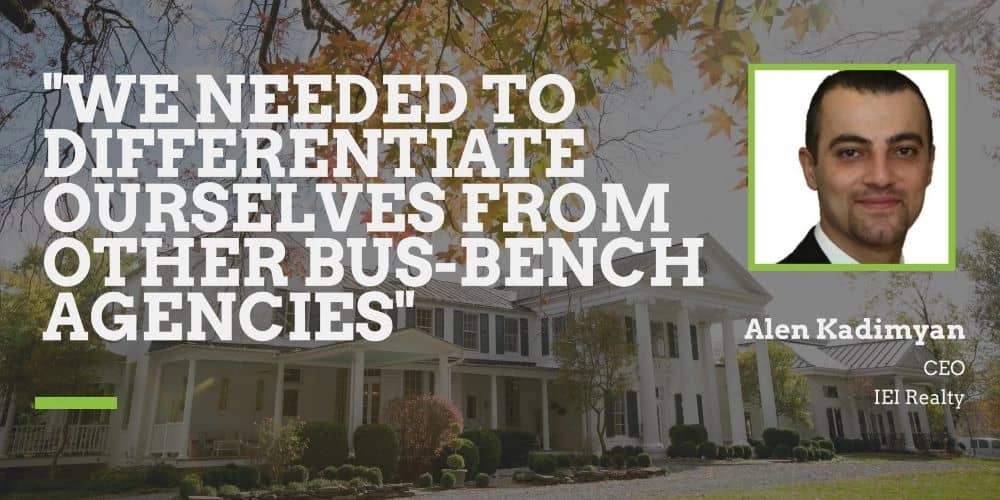
- Unsure of your next move. Here’s the situation: You’re running all the marketing yourself, or you have some in-house marketers on hand. However, you’re struggling to determine or settle on a larger marketing strategy. This is a clue to begin searching for a real estate marketing firm that can help you find your direction.
What to look for in a real estate marketing agency
Benjamin Franklin often advised others to date “with your eyes wide open,” to ensure you don’t go into a relationship blind. This advice applies well to finding the right marketing agency for your real estate brand. Here’s what our experts say to watch for when you’re “courting” a marketing firm.
Do they provide the services you need?
Before searching for real estate marketing services, you should sit down with your team (no matter its size) and discuss which services your brand would benefit from most. This could be digital marketing, PPC, social media, creative strategy, advertising, or any number of services. Once you understand your priorities, you can start looking for creative marketing firms who are experts in those areas.
Kadimyan said that when they began searching for marketing services, they knew exactly what they needed help with. “We needed someone who could help us find a unique voice in our branding, help us market ourselves as millennial-friendly realtors, and help us expand our reach on social media.” These goals made it easy to narrow down their shortlist to the firms who specialized in those areas.
Do they understand real estate?
It’s vital for agencies to know how real estate groups work and how to collaborate with them, according to Kadimyan. “Make sure they understand real estate, selling and buying process, and are familiar with the terminology. Agencies that stay connected via messenger and accommodate the on-the go agency.”
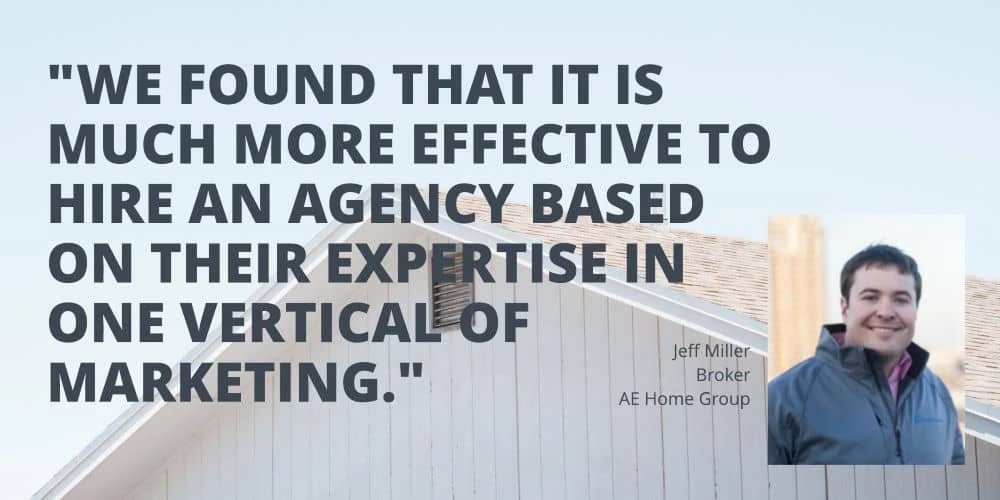
Jeff Miller, a real estate broker with AE Home Group in Maryland, said that marketing agencies who try to be experts at everything only end up being average in their skills. “We found that it is much more effective to hire an agency based on their expertise in one vertical of marketing. Our experience was that being great at one form of marketing yields more leads than being average at all of them. Over time, if we want to expand and obtain more leads, then we would reassess hiring additional agencies who are experts in other verticals.”
Do they understand marketing trends?
A good marketing agency is on top of the latest trends in digital marketing and traditional advertising. They should be able to tell you which mediums, channels and formats are most effective today—and which ones should be left by the wayside. Perhaps most importantly, they should be able to spot opportunities that other marketers are missing.

Evan Roberts, a real estate agent with Dependable Homebuyers, said, “A good marketing agency should be able to guide you on whether direct mail, Google Adwords, Facebook marketing, or print ads are providing a high return, and which calls-to-action are connecting with individuals in your local city. Marketing agencies create their value by saving you money in pursuing strategies that others have found to be ineffective.”
Do they have experience in your area?
Local marketing is big business, but few industries depend on it as much as real estate. Understanding the local areas you serve is business-critical—without that knowledge, your failure is virtually assured. Your marketing efforts should cater to local areas and help you build relationships with local homebuyers and property owners. Therefore, your agency needs to research and immerse themselves in the markets you serve.
Regarding experience in your locality, Roberts said, “As a real estate brokerage, it is critical that your marketing agency have extensive experience in your local area. Every major metropolitan behaves differently. Some tactics work great in some areas while being over-saturated in others.”
Do they share your vision?
You’ve created a vision for your real estate brand. If you want to see your vision come true, then your marketing agency has to understand and support it. The agency you hire will create strategies that impact your brand and business, so you want to make sure they’re on the same page as you.
Your brand’s vision and values should come across in your marketing, from creative advertising to social media to direct mail campaigns. When you find an agency that shares and respects your values, their work for you will reflect that in a compelling, natural way.
Do they play to your unique strengths?
What unique advantages do you already bring to the table?
Most realtors are warm and personable. But you might be a uniquely good writer, photographer, or great in front of a camera. Handling certain tasks yourself lets you play to your strengths and ensure your brand conveys a personal touch.
Real estate is a face-to-face, high-trust industry. It’s important your marketing conveys a personal feel. One potential solution is to focus on tactics that tap into your strengths and hire out the rest piecemeal.
For this to work, your marketing partner must be flexible with their services offered. Don’t get locked into a contract where you’re paying for things you could have done better yourself.
Do they have simple (and transparent) metrics?
Terms like “increased brand exposure” or “better visibility” sound great… but only if they translate into a healthier pipeline of leads and clients. What can’t be measured can’t be improved.
You might not understand all the technologies or tactics a marketing agency might use, but tracking results should be simple. Look for partners with a regular reporting deliverable, or at least access to a dashboard that helps you see new contacts being made and how well they’re responding.
Don’t buy into one of those promised “hands-off” solutions. At a minimum, you’ll want to check the metrics to make sure your investment is justified.
Making the best decision for you
Between all those open houses, impromptu photo shoots and stressful closings, you can’t let marketing fall by the wayside.
Whether you decide to hire a marketing agency or handle it yourself is a personal decision. It also isn’t a completely binary one. You might find that, after experimenting for a few months, a balanced solution—where you handle the parts of marketing you enjoy and hire out the rest—works best.
Bonus: Real estate marketing company comparison chart
When you start looking for real estate marketing firms, it’s easy to run into information overload. To help you get started, here is a comparison of some of the top real estate marketing firms. The chart includes services offered by NYRE, SM Sold, Conway + Partners, Cohn Marketing and 3 Sixty Strategies. Find your perfect combination of SEO, social media and website creation services.
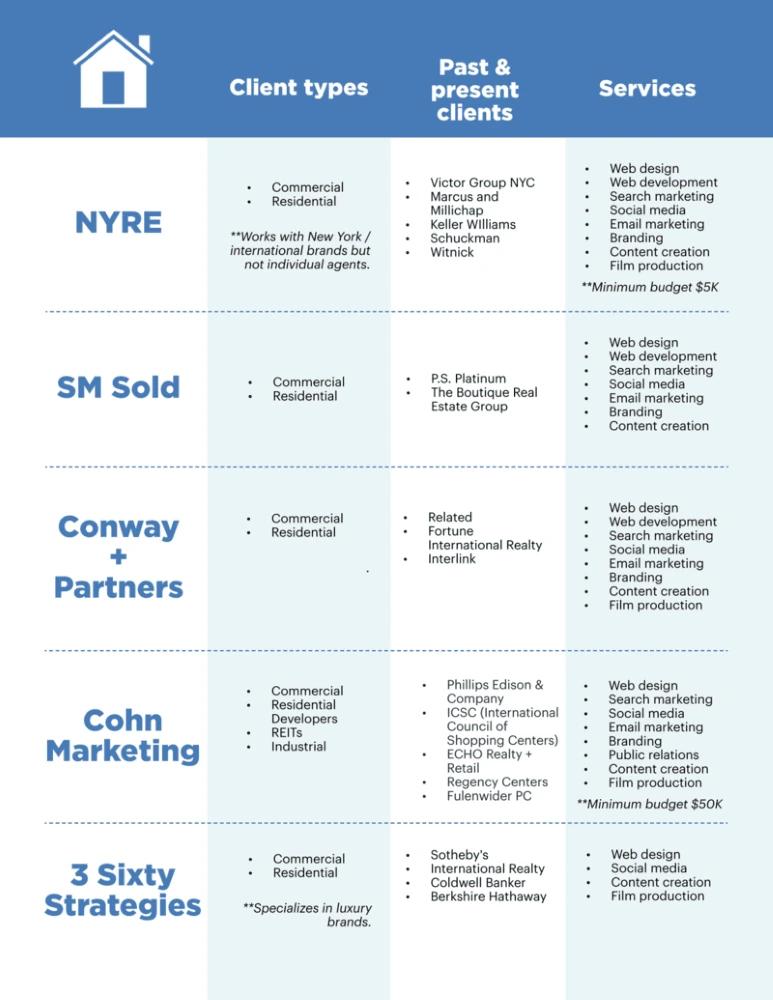
View and download this table here.
You can use this as inspiration to create your own comparison chart in Lucidpress, Google Docs or Excel. This will help you keep track of the different marketing agencies you research, so it’s easier to make your final decision.
Your brand matters. Learn how to protect and elevate your real estate brand in this branding essentials guidebook.
If your real estate business is growing, it’s only a matter of time before you’ll need to reevaluate your marketing strategy. “Growing pains” are definitely real, and your agents will feel the squeeze as you try to scale your marketing efforts for larger audiences.
Related: Should you hire a real estate marketing agency?
When you find yourself at this point, it’s time to automate. Real estate marketing automation software will save agents time and help you reach and nurture leads more effectively. It handles many complex tasks that are either too difficult or time-consuming to do on your own. But like any software, it comes with serious considerations, such as cost and learning curve.
In this post, let’s go over what marketing automation is, how it can help your real estate business, and how to choose the right software for your brand.
What is marketing automation?
Marketing automation is the process of automating certain repetitive marketing tasks. It’s designed to support multiple channels, so your marketing efforts (and your brand) stay consistent across the board. Most marketing automation platforms support websites, emails, and social media.
Marketing automation use cases
Let’s go over a few examples. Here are some of the ways agents can use marketing automation software to work more efficiently.
Reduce cart abandonment. Imagine you sell products on your website. It could be branded merchandise, online courses, or real estate services.
Ideally, when someone adds an item to their cart, they will complete the transaction immediately—but, that’s not always the case. They may have been looking for more information, like shipping prices, before making their decision. Or, maybe they realized they can’t afford to pay today.
Either way, the result is an abandoned cart and lost sales.
Marketing automation software can help you capture this information and add this lead to your database. Then, you can target this lead with a follow-up email that encourages them to return to their cart and finish the sale. You could provide them with a discount, free shipping, or some other enticing offer. This email could be the key to persuading the buyer to complete the sale.
Nurture your blog subscribers. If you’re investing time and resources into content marketing, your goal is to engage an audience who may not be ready to buy today, but they will be in the future. Maintaining an active blog is a popular way to build an engaged audience of subscribers.
So, how do you move these people toward sales?
Real estate marketing automation can help agents set up email campaigns to nurture those blog subscribers. You can even divide your audience into segments and send them relevant, customized content—like local listings. Regular contact will keep your brand top-of-mind, so they think of you first when they need an agent.
Identify leads who are ready to buy. Sometimes, it’s hard to track all the leads in your system and prioritize the ones most ready to buy. You don’t want to miss a sales opportunity while it’s hot, so you decide to prioritize leads who’ve completed certain actions on your website.
But… which activities should you track, and how?
A good marketing automation program will provide reliable data on the actions that demonstrate high interest:
- Landing page visits (such as visiting your pricing page more than once)
- Email opens (like opening a demo email, but not clicking through)
- Lead scoring (assigning a number to a lead based on how many actions they’ve completed)
Based on this information, you can be confident that you’re reaching out to a real estate lead at the right time.
Benefits of marketing automation
Now that you understand what real estate marketing automation is and how it can be used, let’s review the benefits.
Marketing automation software saves time. Creating customized campaigns won’t take as long as it used to. Because your agents don’t have to spend time performing repetitive marketing tasks, they have more time to spend face-to-face with clients—closing more sales.
It makes your advertising more effective. Because marketing automation software uses data to make decisions, you can be more confident that your message is reaching the right people at the right time. From email automation to SMS messaging and mobile push notifications, this software streamlines a variety of marketing techniques, so agents can focus on getting the best results from each.
It makes marketing management easier. Before automation software, agents had to spend hours every week performing repetitive tasks and sifting through the data—introducing many chances for error. Now, a program can manage these things for you, and all you have to do is maintain and optimize your campaigns.
Lead gen best practices
If you’re interested in marketing automation for real estate, you’re probably already generating a fair number of leads. If not, you might want to get your lead generation efforts up and running first, so you can get the most out of your real estate automation software.
In either case, it’s never a bad idea to review lead gen best practices. What makes a good lead generating strategy?
Move leads down the funnel. Remember the classic customer conversion funnel? It describes the journey a buyer makes through the stages of awareness, interest, desire and action. For each stage in this funnel, you should have landing pages and content to match. For example:
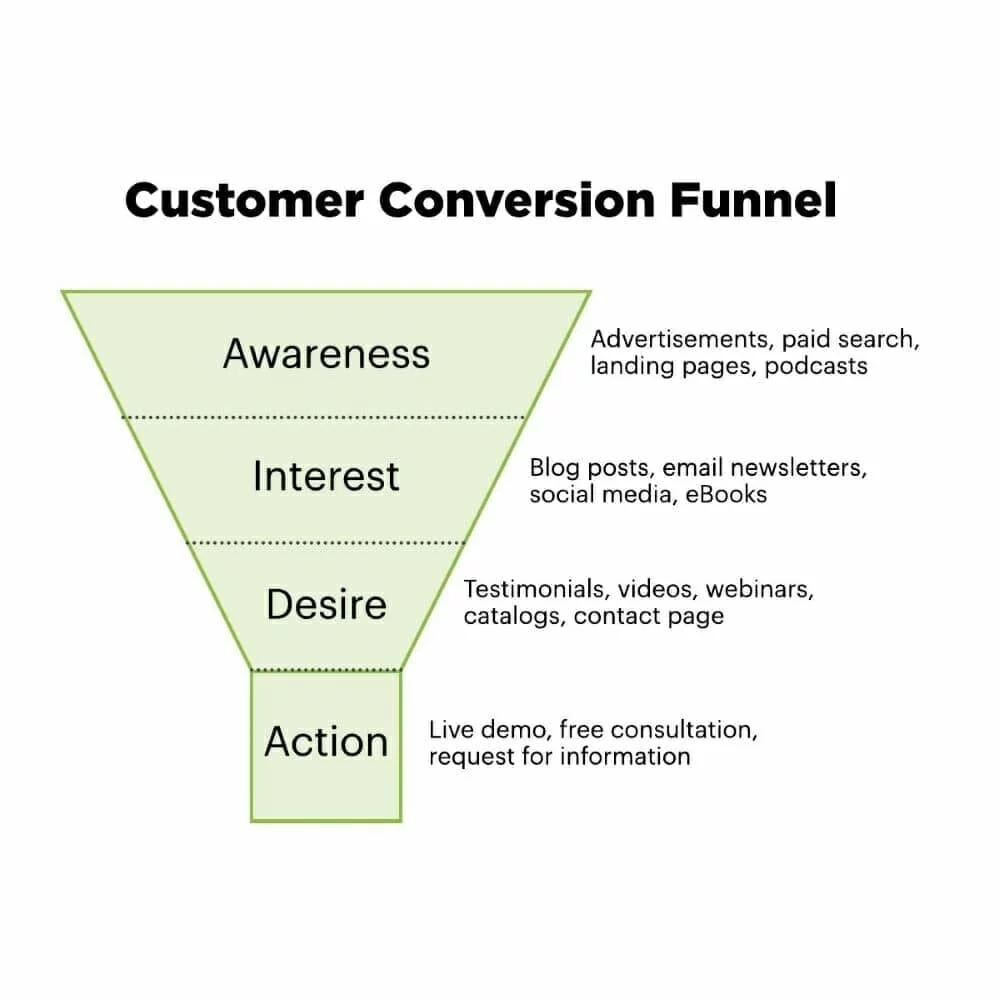
When you have all these pieces in place—and you use clear calls-to-action to connect them—buyers will move seamlessly through the stages with fewer obstacles and objections. Marketing automation software can help you manage and deliver that content, so your leads don’t get lost or go cold.
Build your own email list. If you’re just starting out, it’s tempting to purchase email lists. But when you buy a list of addresses, you’re getting the same tired list that many other agents have used before you. Bottom line—it will never be as effective as the list you build yourself.
Make it easy for people to subscribe to your blog and email newsletters. Put sign-up links on your website, blog and social media channels. Collect email addresses from clients and prospects you interact with, then add them to your email list. Offer incentives to sign up for your email (e.g. coupons, sweepstakes, listings info), and remind people about it both online and offline.
Because this list is targeted and unique to you, you’ll enjoy better open rates, click-through rates, and conversion rates.
Maintain brand consistency. It’s often said that a prospect requires 6 to 8 “touches” from your brand before they become a lead. These touches can come in the form of advertisements, listings, webpages, emails and social media posts—all different channels.
If your brand identity & messaging aren’t consistent, you risk losing and confusing your audience. That’s why brand management is so important. Make sure agents are all using the same brand assets (colors, logos, fonts) and messaging (voice, tone, offers). The consistency will help buyers recognize, remember and trust your brand.
Related: The complete real estate marketing guide
Which software do you need?
To figure out which real estate marketing automation software to use, you have to ask yourself a few questions. The answers will provide a rubric for evaluating all the options out there.
Am I using inbound or outbound marketing? Generally speaking, there are two types of marketing: inbound and outbound.
You can think of outbound as “push marketing,” where you push a message out into the world (e.g. advertisements) in hopes of attracting the right people to your brand. Outbound marketing includes:
- Print & broadcast advertisements
- Direct mail
- Paid social ads
- Paid search & display ads
Conversely, you can think of inbound as “pull marketing,” where you publish and distribute messages (e.g. web content) that interested buyers search for online. Inbound marketing includes:
- Blogging
- Organic social media
- Organic search
- Emails to your list
Which strategy do you use most often? In reality, most real estate brands will use a mixture of both. Outbound marketing is good for building initial brand awareness. Inbound marketing is good for driving qualified leads. Both can contribute to a healthy sales pipeline.
Determining what type of marketing you use the most can help you prioritize which automation software to consider. Some specialize in one or the other, and some cover both.
Which channels do I use (or want to use)? This question dives a little deeper than the last. Rather than thinking in broad categories, get specific about the marketing channels you want to automate.
Different software will specialize in different channels. Make a list of the channels that are “must-haves” and “nice-to-haves.” Your lists could include:
- Website actions
- Social media
- Content publishing
- SMS messaging
- Mobile push notifications
As you can see, the potential of real estate marketing automation goes far beyond email. But, not every agent will need all the bells and whistles. As management, it’s up to you to decide which features are most relevant for your agents. Then you can filter out the software that doesn’t meet your needs—or, perhaps, far exceeds them.
What tools do I need to integrate with? Chances are, you’re already using a slew of programs to manage your business. Marketing automation could replace some of those, but of course, not all. It’s important that your marketing automation software plays nicely with the other tools you’re using.
Linking your marketing automation software to other tools will increase its usefulness. They provide useful data your software can use to make decisions.
Examples of tools you could link to your marketing automation software:
- Salesforce (CRM)
- Microsoft Dynamic (CRM)
- Google Analytics (data)
- Kissmetrics (data)
- Facebook (social)
- LinkedIn (social)
- Eventbrite (events)
There are thousands of examples (just glance at Hubspot’s integrations page to get an idea!). Take a close look at which tools you could replace with marketing automation and which tools you’d need to integrate.
Related: Real estate marketing software that outperforms competitors like Imprev
Important evaluation criteria
It’s not just the software that you’re evaluating—there are other reasons to choose one program over another. Here are a couple of additional considerations.
Implementation and ramp-up. Setting up a new software is not an easy task, especially one as complex as marketing automation software. (Switching from one software to another can be even harder, as we learned here at Lucidpress when we switched from Hubspot to Marketo.)
Make sure you have a plan and a timeline for implementing the new software: importing data, connecting tools, adjusting code, and setting up initial campaigns.
Also think about the ramp-up. Which campaigns are absolutely necessary to get started? Which ones can you hold off or pause while you get up to speed?
There’s also adoption: Who needs to learn and use this software regularly? Make sure you have any training resources you need, and that all agents are on the same page.
Service and support. If something breaks or doesn’t work, who do you call? If you’re comfortable troubleshooting yourself—or if you have an IT person—you might not need additional support from your marketing automation provider.
But if you’re not, it’s worth asking about services and support. What’s included in your subscription? If your agents need more help or training, is there an extra cost associated with that? How responsive is their team? You can include all of these in your evaluation.
Marketing automation comparison chart
Now that you know what marketing automation is and how it could help grow your real estate business, it’s time to start evaluating providers. We’ve chosen a handful of software programs that are popular with real estate brands and compared them below.

View and download this table here.
To find out more about the 7 programs in our chart, visit their websites:
You can use this as inspiration to create your own comparison chart in Lucidpress, Google Docs or Excel. This will help you keep track of the marketing automation software you research, so it’s easier to make your final decision.
Your brand matters. Learn how to protect and elevate your real estate brand in this branding essentials guidebook.
Marketing is getting tougher and tougher—there’s no doubting that.
With 41% of brands planning to significantly increase their marketing budgets this year, and customers becoming choosier than ever, you wouldn’t be alone if you’re exploring new techniques to get more out of your marketing cash.
Related: The complete real estate marketing guide
One strategy you should consider is SMS marketing, the process of sending short text messages to your ideal customers in an attempt to engage them with your campaign and get them to convert.
Even though average open rates for SMS messages beat email by a whopping 28%, your real estate company sells homes for a large price—unlike small-ticket items that can be purchased on a lunch break.
So, how can you make text message marketing your biggest driver of website traffic, leads and sales?
Here are the five steps you’ll need to build out your mobile real estate marketing strategy, as well as two brands who are already killing it with their text messages.
1. Determine who you want to contact
Just like any marketing strategy, you’ll need to base your mobile marketing campaign on buyer personas—a clearly defined document that lists details about your ideal customer.
For real estate companies selling student accommodation, that might include:
- People with less than $20,000 to spend
- Between the ages of 18 and 25
- No long-term commitments
- Currently living within 5 miles of the local college
Once you’ve got this to a T, you’re left with a bunch of shared interests. Use this information to find the people you want to target with your text messages.
2. Collect their information
The next step in your real estate text message marketing strategy is to collect the information of the people you’re targeting. You can do this by taking advantage of your other marketing strategies.
For example: why not run a Facebook ad, using the details you defined in your buyer persona, to encourage them to fill in a form? (You might need to offer an incentive to do this, such as a free ebook or a guide to purchasing a new home.)
But once you’ve got their information, don’t push the Send button just yet. You’ll need to have explicit permission from your prospect before sending an email, or you could land a hefty fine—and an unhappy buyer.
3. Choose an SMS marketing platform
While purchasing a new phone to send out your new messages is a great way to get started, it’s wise to invest in an SMS marketing platform from the outset.
That way, you can:
- Track various metrics after you send, including open and response rates
- Send SMS messages in bulk
- Personalize each message you’re sending
- View your strategy online, and share with other staff on your marketing team
Platforms like Text Local, Text Request and Textedly can help with this, just to name a few.
4. Select a text messaging schedule
Gotten to grips with your new software? Awesome! It’s time to make a start on your text messaging schedule.
You’ll want to put some thought into the time of day you’re messaging your potential buyers, and the day of the week they’re being delivered.
Why? Well, because texting your customer at 11pm could frustrate them—they’re likely to be asleep. However, sending an SMS message at 5pm could reach your customer when they’re on their daily commute with time to respond.
Find the perfect schedule by referring back to your buyer personas and filling out a daily routine for them.
Remember: You want to push your messages at times they’re unlikely to be busy—and have time to invest into their search for a new home.
5. Perfect your messages
Before rushing off and sending the first message that comes to your head, take some time to think about what you’re actually sending. You don’t want to send 10 messages only to find a spelling mistake, right?
Use key copywriting principles to make your sales messages as effective as possible, and focus on replicating your ideal customer’s language.
Going back to our example of student accommodation, this example:
“Ready to let your hair down at this years’ Homecoming? Make sure you’ve got somewhere safe to call home. Reply PARTY to find five local student dorms near Stamford from just $200/month.”
…would be much better than:
“With stunning high ceilings and low-interest mortgages, find student accommodation near Stamford to help with your studies. Reply YES to opt-in.”
Why? Because it’s avoiding the overused jargon that would push them away and making your real estate brand feel more relatable.
2 awesome examples of real estate companies using SMS marketing
Ready to make a start on your SMS marketing strategy and see tons of new leads roll in?
Here are two awesome examples of real estate companies nailing their text message marketing strategy to provide inspiration for your own.
1. “Text for more information”
Earlier, we listed collecting your potential buyer’s information as a key part of your SMS marketing strategy.
…But, what if you could collect their information by asking them to hand it over in a way that suits them?
This real estate company used this idea on one of their “for sale” signs, asking potential buyers to text a number for more information on the listing. It’s a fantastic way to personalize the texts you’re sending—and make sure you’re only focusing on people who are actually interested.
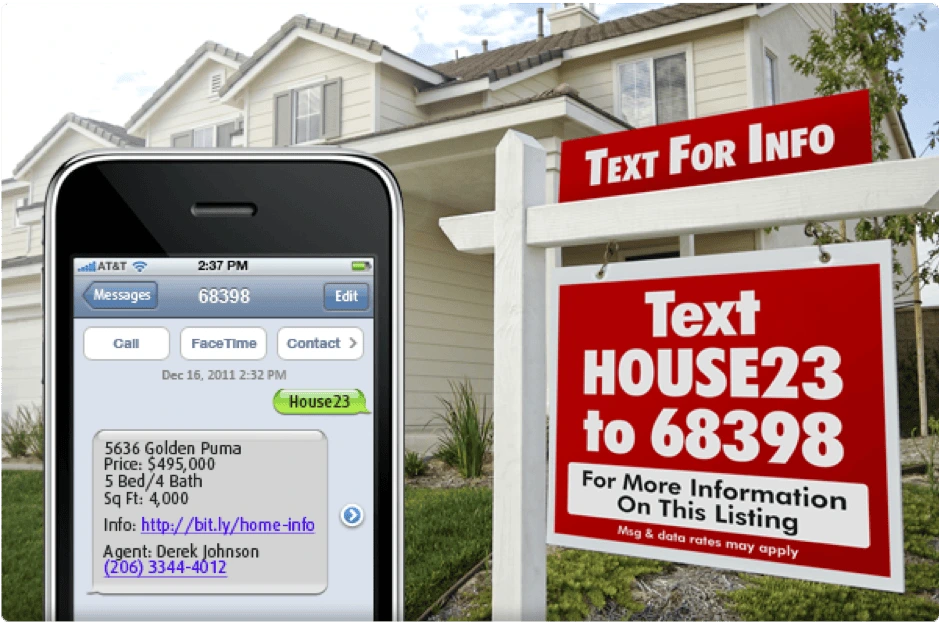
2. Asking for more information
Another fantastic way to engage your potential real estate buyers through text is to ask them for more information, based off the data you’ve already got from them—like this example:
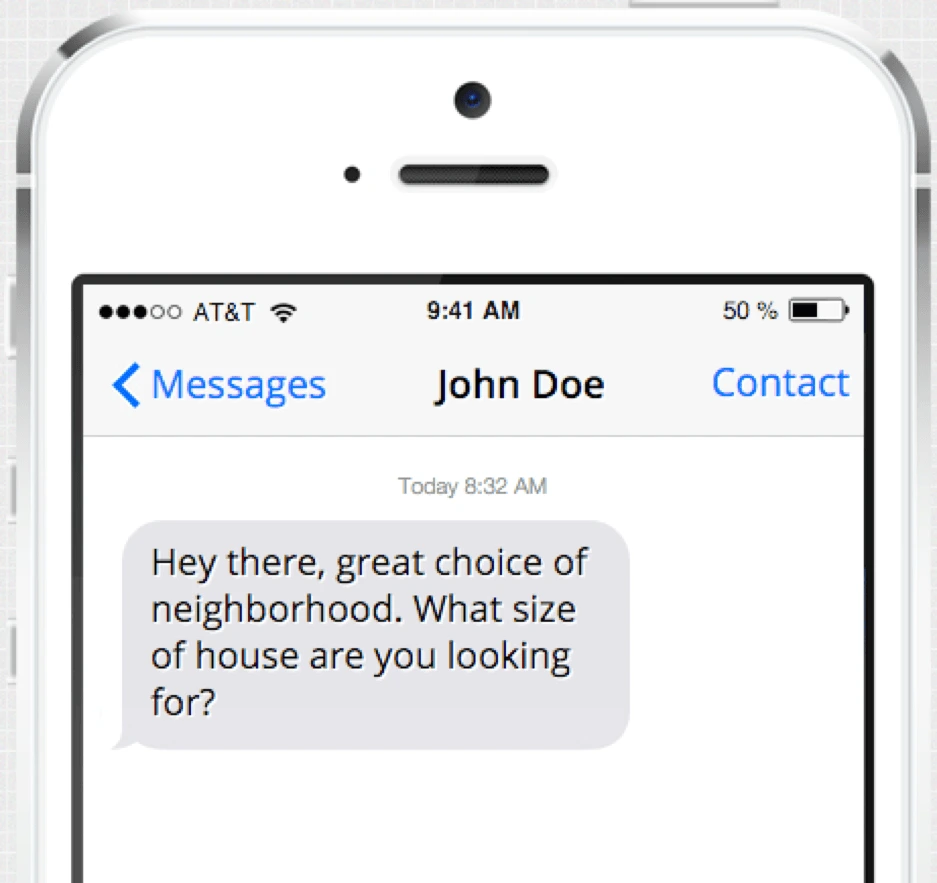
But, why does this work so well?
Well, the prospect doesn’t feel like they’re being contacted by someone out of the blue. They’ve mentioned previous information that’s already been shared (the choice of neighborhood), while asking for more in a way that prompts a response.
Key takeaway
Once you’ve made a dent in SMS marketing for your real estate company, we’re confident you’ll soon see a boost in new inquiries about your properties.
However, don’t forget that it may take some time to see results from your text message marketing strategy. Collecting customer information and perfecting your message can take a while, but don’t give up—you’re almost there.
Your brand matters. Learn how to protect and elevate your real estate brand in this branding essentials guidebook.
Have you spent thousands of dollars on direct mail campaigns with no luck?
You shouldn’t chalk it up to failure just yet. Every great marketing campaign has a solid follow-up campaign behind it.
Sending out three months of direct mail, expecting a deal to happen, and giving up is not creating a business. It’s dabbling.
On average, it takes 12 touches for a deal to happen. However, 44% of people trying to get a deal under contract give up after the first follow-up.
Related: 5 best practices of highly effective direct mail marketing campaigns
I see a lot of real estate investors sending direct mail to find off-market deals. The biggest hurdle most have is that they spend hundreds or even thousands of dollars on a direct mail campaign without obtaining any leads. Then, they send out the same campaign again the following month with the same results.
This is when most people either quit sending direct mail or buy a new list to mail because the old list “wasn’t working.” Not getting any leads from mailing a list doesn’t mean that the list didn’t work—it just means the people you were mailing weren’t ready to sell. Direct mail marketing in real estate is all about timing.
To get a consistent pipeline of deals, you have to implement a great follow-up campaign. This article will walk you through how to set your follow-up strategy.
Following up across multiple channels
The strategy outlined below uses multiple channels to complement your direct mail campaign.
Don’t worry, it’s not going to cost you much more. In fact, it’s going to make those 12 touches a little less burdensome on your budget. Let’s dive in.
Build the right list for direct mail
The first step, of course, is to send out your direct mail. To get rolling with this, start by pulling the list that you’re going to mail.
You can use a list service company like ListSource to purchase a list of people to mail. The types of lists you should be targeting are problematic lists like:
- Probate
- Foreclosure
- Tax-delinquent
- Divorce
- Vacant house
Make sure that you’re filtering out people who have little to no equity. To do this, set your filters to include people with 60-100% equity in their property. This will give you enough breathing room to get the property at a discount.
The other criteria you need to meet is Last Sold Date. We’ve had people call us and say, “I just built this house for retirement three years ago. There’s no way I’m selling it.” Granted, this may not always be the case, but we set our Last Sold Date to 8 years ago or more.
Figure out your farm area
Figure out what your farm area will be starting out. Remember that you have a smaller budget, team, and amount of time as you build momentum. Your farm area will grow as your deal flow grows. Focus on mailing an area that you can comfortably mail consistently every month.
If you work in an office, figure out the radius you want to farm around your home and work. Starting out, we chose a 20-mile radius. The distance isn’t what’s important—it’s how long it takes you to get to the houses within this radius. You don’t want to miss deals because you’re spreading your leads out too far and can’t get to all your appointments quick enough.
We recommend keeping it within 45 minutes. This will give you time to schedule multiple appointments each day as you consistently mail homeowners over time and the lead volume increases.
There’s a cool trick on Free Map Tools that lets you drop a pin, set your desired radius, and get a list of all zip codes within that radius. With this, you can easily pick the zip codes for your farming area around your workplace and home.
Optimize your postcards
What you put on your postcards is up to you, and how postcards perform in each market varies. For our market, plain white postcards with a handwritten font perform the best. (When your prospect has a stack of ten postcards that look like ads and one that looks like a hand-written note, which do you think will stand out more to that person?)
Regardless of the design, make sure you include your company’s name along with your website. The people receiving these postcards will check to see that you’re a credible company before doing business with you. We put Breyer Home Buyers and www.eastatlhomebuyers.com on all our postcards to make it easy to find us online.
If you’re sending direct mail solely to people who are going through a divorce, then you can create a divorce landing page with a URL like www.yourcompany.com/divorce. This gives you the option to retarget visitors using Facebook Ads and Google AdWords. You can do this with any mailing list: tax-delinquent, vacant houses, foreclosures, etc.
Call recipients about your postcard
Your list provider can give you phone numbers for contacts within your farm area. If you keep them in an Excel spreadsheet, you can upload them into a dialer like MOJO. MOJO lets you call hundreds of people in a very condensed timeframe. For our business, we average 71 calls per hour. Of those 71 people, we reach around 30 per hour. We use virtual assistants to call for us, which saves our company significant amounts of money.
To use MOJO, you’ll need a Skype account. MOJO connects to Skype so you can make calls within the U.S. for free, even if you use a virtual assistant.
Remember that when you’re calling prospects to follow up on your direct mail, you should mention your company’s name and that you sent them a postcard. This will jog their memory and make it more likely that they’ll look at the postcard again.
Retarget prospects with Facebook
You can use Facebook and Google Ads to retarget your prospects. Retargeting is cheaper than marketing to cold prospects with these channels. And these prospects have already seen your direct mail, landed on your website, and received a call from you. When they see your ad and click on it, they’re more likely to convert, which provides you with a higher ROI.
The other benefit is that most of us are too busy to immediately respond to marketing. Maybe your prospects were taking their kids out to eat when they drove by the mailbox and got your postcard. Maybe they were waiting on a meeting to start when they looked up your website. Maybe they lost your postcard and couldn’t find you again. Regardless, retargeting helps you pop back up in front of your prospect when they need it most.
Send an SMS blast
There’s no replacing a phone call, but sending a text message is a great way to get in touch with people who don’t like talking on the phone. We use EZ Texting to follow up with people through text. We simply upload an Excel spreadsheet of our contacts, then blast the same message to the entire list.
We usually send out open-ended questions like “Have you sold your property yet?” But, there’s no magic message. The goal is to start a dialogue, so you can make an offer to buy their property.
We’ve gotten several properties under contract without ever speaking to the homeowners on the phone, by doing all the rapport-building and negotiation over text.
Leave voicemails on landlines
Tools like Sly Broadcast let you pre-record a voice message and send it to the phone numbers on your list. It’s important to note that this service only drops voicemails to landlines, not cell phones. Using this in conjunction with the text blast will make sure you’re touching all phone types.
MOJO Dialer also drops voicemails when you’re power-dialing, but the key difference is that you are actually calling someone and will have to speak with them if they answer. With Sly Broadcast, the phones don’t ring, but a voicemail shows up on their answering machine.
Schedule your follow-up campaign
When we’re planning our direct mail campaigns, we schedule the arrival date of those mail pieces—meaning that we know (within one day) when those mail pieces will be delivered. We usually have our mail dropped on Tuesday because our response rates are higher on Tuesday.
Here’s what our follow up campaign looks like:
- Week 1: Direct mail delivered on Tuesday
- Week 1: Begin Google AdWords and Facebook retargeting
- Week 2: Cold call prospects
- Week 3: Text prospects
- Week 4: Voicemail drop
- Week 5: Repeat mailing to the same list
- Week 6: Repeat cold calling to the same list
- Week 7: Repeat texts to the same list
- Week 8: Repeat voicemail drop to the same list
With retargeting, you set it up once and keep it running. We don’t stop the Facebook and AdWords campaigns. Your goal should be to contact each prospect with a phone call, a postcard, a text, and a voicemail drop each month.
Why you should always follow up
Homeowners usually aren’t ready to sell when you first reach out to them. Granted, sometimes we do get lucky and close a deal on the first mailing. But, it usually takes us at least three mailings to get a deal from a campaign.
If you label your direct mail campaign a failure because you haven’t gotten a deal right away, then you risk missing out on future leads and give yourself zero return on your investment.
If you look out over the year and set a goal for 5 deals to get the real estate investing ball rolling, you’ll create a marketing plan to reach that goal. However, if you keep changing your marketing strategy because you haven’t given yourself enough time to make it work, then you’ll never reach it.
Ready to create your own direct mail designs in minutes? Check out our direct mail postcard templates.

Or, learn more about the new direct mail features in Lucidpress and give it a test drive.
You’ve built a great website and have an impressive email database, and you’ve even built a decent following for your brand by following tips you’ve read in real estate marketing guides.
Now you want to know what content you need to keep you at the front of the pack.
Related: Real estate branding—a comprehensive guide
First, while it’s true Google likes fresh content, mediocre fresh content will not help you. Prospective clients look for informative, valuable or entertaining content that prioritizes high-quality visual design.
If you’re searching for ways to do that, here are our tips on how to post great real estate content for your audience.
Why content marketing in real estate?
Content marketing is a valuable tool for building up brand awareness and driving leads. Blog posts optimized to show up in search engines can drive organic traffic to your website saving you from paying for ads and media buys month after month. Building up a presence on social media as a skilled real estate agent can help drive referrals and help potential clients to think of you the next time they are considering buying or selling a home.
Generating real estate content marketing ideas
In content marketing quality is better than quantity. Agents will see a much higher return on investment by focusing on generating content that potential business leads will be interested in. Before sitting down and coming up with a list of ideas, think about what your overall content strategy will be. How will potential business leads find your content? Is there a particular content marketing platform you will use?
Some common channels include:
- Search engine optimization (SEO)
- Social media
- Communities such as Facebook groups
- Content co-creation
By selecting one or two channels to focus on you will be better able to come up with content ideas that will perform well. If you are focusing on SEO, use keyword research tools such as SpyFu, Ahrefs or the Google Ads planner to identify topics people search for that are relevant to your industry. If you’re focusing on social media, communities or co-creation, get to know what members frequently discuss and brainstorm content you can create that will be relevant and useful to that audience.
Hire a good writer
We’ve all been drawn to some click-baity content at some point, often because we’re drawn in by an enticing headline.
By now, however, most of us realize that anything that claims to be jaw-dropping (like “You won’t believe what happened to this third grader when he opened his lunch”) isn’t actually worth clicking. Your real estate clients want content with more substance—information that relates directly to the industry—and to get that, you need to find a good copywriter.
You might already have a talented writer on staff who knows how to write good articles about rent rates, homeownership and mortgage financing. Otherwise, you can reach out to a PR firm or real estate marketing agency that specializes in content.
What should you publish?
Whether you’re marketing an apartment unit in Chicago, Illinois, or a New York City micro-apartment, the place to start is with website copy, blogs and newsletters.
If your website has been around for a few years, make sure it’s up-to-date and that the copy is fresh.
Publish a blog post at least once a week, and make it better than all the regurgitated content out there. Newsletters can help you spread the word, and there are still many real estate pros who send newsletters by snail mail.
For a look at a few shining examples in the real estate industry, check out this list of the top real estate blogs.
Once you’ve mastered the basics, remember content marketing is more than just blogging. Visual content such as infographics, photos and videos perform well on social media and can better communicate ideas that are difficult to describe.
Repurposing a blog post into an infographic or video is also a great way to spruce up your email marketing and send engaging content to readers who don’t have time to read an entire blog post.
Long-form content such as ebooks or webinars are also effective lead generation tools. Provide a guide to buying your first home or investing in a rental property and ask for a name and email to access it. Then place your new contacts in an email campaign and nurture those leads into your next client.
What should you say?
Your website should clearly and cleverly explain who you are and what you do. Blogs can cover a variety of subjects that your clients are interested in, like:
- Saving energy
- Lawn care tips
- Home winterization
- Interest rate trends
- Financing pitfalls
Your newsletters should be more specific, covering:
- New listings
- Market trends
- Financing trends
- Economic projections
- Recent sales
Each month, you can highlight a relevant, timely subject like:
- Summer pest control
- Preventative HVAC maintenance
- Cleaning out the gutters
- Lawnmower winterization
Remember: You’re the expert
A client who’s trusting a real estate agent to sell their home or purchase a new one will feel far more comfortable if you can show you know the neighborhood inside and out.
That’s why your content should cover local interests like reviews of new restaurants, lists of local daycare centers, and articles about any subject that make it clear you thoroughly understand the community.
Expert guides are a great way to establish credibility. Try researching and writing about things like:
- How to finance your first home
- Cleaning up your credit score
- What to do after your offer has been accepted
- Avoiding the bad-faith offer
- How to market your first property
- Marketing tools you must use as a real estate agent
Key takeaway: Content rules
It’s a digital world, and content is king.
While there’s still plenty of room for traditional marketing, most of your content will be published online. Make sure it’s timely, well-written, and of course, original.
Most of all, your content should be engaging and informative. If you can provide value to your readers, they’ll remember you any time they need your services, because you’ve already established yourself as a professional who they can trust.
Learn more about building a strong brand with this free guide to real estate branding.
When you send out direct mail to prospects in real estate, it’s inevitable that you’re going to get calls from seemingly unmotivated people. If you’re not drawing motivation from your leads, then your competition will be converting your leads instead of you.
Related: How to follow up your real estate direct mail campaigns
Based on the process I use for my own business, this article will teach you how to answer calls from inbound leads and how to handle appointments.
Follow a call frame
A lot of gurus will provide everyone with a script, but if you’re following a script and the conversation steers away from it, you’re going to sound salesy and unnatural to your leads. You need to have a frame to work with rather than an exact word-for-word script, because the nature of your calls will be dynamic.
We follow a call frame that looks like this:
- Set your time frame.
- Set your agenda.
- Determine your outcome.
This makes your conversations feel more natural, giving you room to implement strategy as the opportunity occurs (instead of trying to bend the conversation to your will).
Set your time frame
Whether someone calls you in response to your direct mail campaign or you’re just returning their call, the prospect has no idea what to expect. Our goal is to inform them, so we put them more at ease.
Of course, sometimes the timing isn’t ideal. What if your prospect was taking a break at work when they called you, and by the time you call back, they’re hiding in their cubicle and whispering to avoid being overheard? You won’t be able to take them through the entire sales process on the call, cutting yourself short.
To avoid being cut off, we always begin the call by letting them know it should only take about 5 to 10 minutes, and we make sure that works for them. Most of the time, it does. On the rare occasion that it doesn’t, we schedule a time to call back when they’re able to talk. We want their full attention—so they aren’t focusing on when they have to get off the phone.
An example of how this introduction might sound:
“This call will take me 5 to 10 minutes to answer all of your questions, ask you some of our own questions about the property, and explain what the process will be moving forward if we decide that this house would be a good fit.”
Set your agenda
Along with setting the time frame, the introduction needs to tell the prospect what will be happening on the call. Remember, they don’t know what to expect. Most likely, they’re on guard.
We set the agenda of the call by acknowledging that they probably have a few questions for us, assuring them that we will answer their questions. We add that we have a few questions for them, and that if we are a good fit for them, we’ll proceed to the next step in the process.
When you set an agenda with your prospect, you’re building credibility and trust. You’re handling the call in a professional manner that sets you apart from your competition—especially when they’re getting handfuls of direct mail saying “We buy houses.” We’ve gone to appointments where homeowners had stacks of direct mail from real estate investors. Going the extra mile to build trust will definitely help you stand out.
Acknowledge their questions
When you mention that you’re aware they probably have questions, you’re giving them permission to ask all the questions they want. After all, selling a house to an investor is a big deal.
People traditionally sell houses through a realtor, which can take months to close. With an investor, it could take only a couple of weeks. There are lots of questions lingering in a seller’s mind, and they deserve to ask and be reassured that this is right for them. Transparency will only help you.
Inform them of the next step
Near the end of the call, we usually know whether or not it makes sense to move forward. This is where you remind them that, if this isn’t a good fit, it’s totally okay to say no. People love being able to say no because it gives them a sense of freedom and comfort in the process. They know that you won’t pressure them if they decide this isn’t the route they want to take. Once you take the pressure off, you can really dig into the motivations of the seller.
“If you’d like to get our best offer on the property, we’d have to come out to see it and verify that the conditions match our repair estimates. The appointment should only take 30 minutes to an hour. We’ll just walk through the property and check out the condition. After that, we can make you an offer, down to the penny. If that works for you, I can schedule the appointment for Monday at 1 p.m. or Tuesday at 9 a.m.”
Determine the outcome
Do you ever find yourself hanging up the phone with an inbound lead, wondering how the phone call went? Determining your outcome on the phone and setting expectations provides clarity on what you need to do next in the process—whether that’s determining it’s a dead lead, dropping them into the follow-up process, or going to an appointment.
So, you’ve determined that the prospect needs your services while on the phone. You’ll want to explain what the process looks like at the appointment. This includes how long it takes, what you’ll do at the property, when they can expect to receive an offer, and what their options are. After explaining this process, set the appointment. Now you and the homeowner have a clear idea what’s going to happen next.
If you determine that your services don’t align with the homeowner’s needs, then explain to them that you don’t want to waste their time and you don’t believe you’re the best solution for them. Always genuinely offer to point them to a service provider who could help them. Offer your network of real estate agents, property managers and contractors to see if you can help them further.
Determine their motivation
The goal of any call with a prospect is to determine their level of motivation. One way to gauge this is to “go negative.” This simply means to pull back from them throughout the conversation.
The analogy goes that, if you chase a dog, they will run away. But, if you run away from a dog, they will chase you. Going negative will help you determine if the person is a legitimate lead, meaning you’ll know whether they have a problem your company can truly solve. Simply put, you just act a little less interested in your prospect to see if it makes sense to do business together.
Examples of going negative:
- “It seems like a great property. I’m not sure why you would want to sell it.”
- “It seems like this property would make a great rental. Have you considered just keeping it and renting it?”
- “It sounds like you’re looking for top-dollar on the property. Have you considered listing it with a realtor? It’ll take a little longer, but you’ll get the most money.”
There are two benefits to using this strategy. One, you’ll flush out all the normal objections a potential seller could have by bringing them up first (prompting them to justify why that won’t work). For example, you might hear something like, “No, I hate working with realtors. I just want to sell it and be done with it.”
Flushing out the objections will clear a path for you. As investors, we have to make lower offers so that we can turn a profit for our business. If you don’t flush out the objections, you will get responses like, “You know what? That’s a little low. I think I’ll just keep it as a rental or list it with a realtor.” After you’ve flushed out these objections, they can’t use them anymore. They just told you they didn’t want to keep it, rent it or list it.
The second benefit is that you determine their motivation. Sometimes, we cover so many objections that sellers just say, “I don’t want to do any of this. I just want to sell it to you guys and be done with it. Give me an offer.” In the seller’s mind, you’ve become their best option.
“Just give me an offer.”
We encounter it daily. People will put on their negotiation mask and demand an offer over the phone. When we started up our business, we’d always try to justify why we need to see the property to verify its condition. It hardly ever worked.
So, we switched up our approach. When someone demands an offer from us right away, we ask, “Would you rather have an offer, or would you rather have our best offer?”
The obvious answer is that they want our best offer. At this point, sellers usually quit hassling us about getting a quick offer. We explain that, to make an intelligent offer, we need to see the property and make a list of repairs needed to get the offer down to the penny. This flushes out people who are simply shopping offers, and it saves your company time and money when you avoid them.
Key takeaway
Now you have a call framework to draw out motivation from your direct mail inbound calls. Don’t get caught up in the nitty-gritty of a script. Instead, focus on getting your prospect’s guard down, setting expectations, going negative to gauge their motivation, and setting an appointment with them.
Want more great tips on how to set up real estate marketing campaigns? Check out our comprehensive real estate marketing guide for ideas & inspiration.
Like every other industry, real estate has experienced rapid change due to new technologies. Perhaps the area that’s felt the most impact is marketing. It’s imperative to keep up with how it’s evolving to stay ahead.
Although direct advertising methods are still popular in real estate marketing, they’re not the only way to help consumers change their minds. That’s where influencer marketing comes in.
Related: How to boost your brand identity with influencer marketing
Word-of-mouth is no longer limited to meeting people in person; it’s expanded to include social media, too. Influencer marketing in real estate aims to draw in potential clients with content they’ll find engaging and valuable. Here are five influencer marketing strategies your brand can try.
Don’t underestimate the power of Facebook
Facebook offers ample opportunities for influencer marketers to connect with audiences organically. For example, you have personal pages, business pages & groups, all of which can provide multiple touchpoints.
There are various content options, such as photos, blog articles and videos, through which you can engage potential clients. Facebook posts that get the most likes are creative, genuine and have your brand’s personality written all over them.
In addition, Facebook is proven to be a brilliant tool to expand your database and sphere of influence. Personal interactions, even a simple birthday wish, are a great way to reconnect with clients and remind them you’re available.
Work with a combination of influencers
Many brands make the mistake of pairing up with the wrong influencers. Not every influencer will work for you, so it’s best to realize this early on. Influencers can usually be divided into three categories: mega-influencers (celebrities), macro-influencers (well-known), and micro-influencers (niche).
To determine which influencer would be right for you, you need to define your target audience. Are you looking to attract families and professionals? Perhaps millennials? People tend to follow influencers that represent the lifestyle they hope to achieve.
Many real estate brands choose a variety of influencers to maximize their reach on different platforms. The best influencer would be the one who’s most relevant to your campaign and can reach the most significant potential audience.
Be creative with video marketing
Video marketing, today, is a force to reckon with. Video marketing stats show 84% of consumers choose to buy something after watching a video and, by 2020, 82% of all consumer web traffic will be video. Compared to content that’s text-based, video has proven to be very effective and is perhaps the biggest trend for content marketing this year.
What does it mean for real estate brands? Well, it means more creativity. Audiences aren’t interested in the same old content anymore and are looking for something that’s authentic and hits home. Videos seem genuine, are fun, and add a degree of reality to the business.
A brilliant example of video marketing is Bedrock Real Estate’s “Anthem of Us” to encourage purchases in the Detroit area. The award-winning video starts off with a voiceover by rapper Big Sean (a native of Detroit) and highlights its culture and, most importantly, its people.
The video employs the use of a mega-influencer and multiple micro-influencers, a combination that hits the bullseye. Big Sean’s voiceover would be not worth sharing if it weren’t for the local people & businesses whose promotion led to the video going viral. The micro-influencers played a massive role in the campaign gaining ground locally, so if you’re aiming for a regional campaign, then local influencers might be more effective than international ones.
Related: Real estate video marketing — The ultimate content marketing tool
Build long-term relationships
With the growth of influencer marketing, the demand for influencers is at an all-time high. The number of brands getting in on the game has led to a rise in cost. In the past, brands could get away with free products as a form of compensation—not anymore.
Today, brands have to invest more time and effort in working with influencers. Once you’ve built a healthy relationship, you can ask them to promote your content. Perhaps the best way to get a referral is to make your influencer a client and have them share their own positive experience with their followers. There’s nothing more impactful than a genuine review.
Invest in Instagram
Last year, Instagram ranked as the best platform for influencer marketing campaigns. There are over 800 million users using the app every month, and that number is still rising.
Influencer marketing is likely to cross $2 billion by 2019, and Instagram is the best platform to use for brands and influencers alike. Its visual nature inspires you to get creative with your content and grab the attention of your target audience.
The best content on Instagram doesn’t just flaunt your product; it flaunts your personality. Don’t just post pictures of luxurious houses—post pictures of what makes it a home, too. How about a dog in the backyard? Or people enjoying food at the open house?
Influencer event marketing, in particular, is gaining momentum and is something you should start thinking about. Host an event and invite people with large followings to attend. The influencers are then responsible for creating engaging content that will drive awareness for your brand.

Source: Instagram
For instance, look at the photo above. Isn’t it gorgeous and fun? Would you believe me if I told you it’s from an open house in Los Angeles and the woman in the photo is an influencer?
The open house was set up in the most Instagram-worthy fashion and encouraged social media sharing. These real estate professionals understood the importance of making open houses seem less like what they are and more like a fun, eye-catching event that’s worth telling your friends about.
Key takeaway
Influencer marketing can boost your brand awareness efforts and be a valuable addition to your content marketing arsenal. The right influencer and the right platform are bound to set you on the road to success.
One of the biggest challenges realtors face in today’s market is the planning and implementation of an effective real estate listing marketing plan.
The opportunities and expectations have changed and grown exponentially over the past decade or so, and with so many avenues and moving parts, it’s not easy to nail down a real estate marketing plan and stick to it.
Related: How to build a social media campaign for real estate (with templates)
The benefits of getting it right, however, can be huge, so it’s a challenge that every determined broker or agent needs to overcome.
Components of an effective real estate listing marketing plan
First, as a small or medium-sized real estate agency, you need a listing marketing plan that’s high-impact.
Why? Because you need every dollar to count. You don’t have the budget for this to be solely about brand identity—you need to move real estate listings consistently.
By building an intentional and strategic marketing plan, you’ll increase your chances of getting that tenfold. So, where do you start?
The important thing to understand is that every element that makes up your real estate marketing ecosystem should be connected, usually in more ways than one. That’s how you move your audience through the sales funnel.
To achieve that, you’ll need to start with an overview: a top-level view of how each aspect of your plan links together. A simple diagram will do the trick here, so long as it gives you a clear view of how everything is connected.
Start by creating a goal and measurable objectives for your marketing plan. Think of your goal as your overall vision for the plan. For example, a listing goal could be selling a listing at above market value. Measurable objectives could include having a certain number of attendees at an open house or a certain number of emails or phone calls from a direct mail campaign.
Once you’re goals are in place, it’s easy to identify which marketing strategies and tactics you should focus on in your plan. In your diagram, start with your goals up top. Then link to your objectives and list each strategy under that.
Once you have that, you can begin to look at each element individually to ensure you’re maximizing its effect. More on that shortly.
First, a reminder that this isn’t about throwing out the feelers to see what sticks, only to try the same thing again next year because you’re not sure what really worked.
For everything you do, you’ll need to follow these three critical steps:
- Measure
- Analyze
- Refine
If you’re serious about making this work, you must implement processes for measuring your efforts. Then, once you’ve got the data, sit down with all key decision makers to analyze what’s working. From there, you’ll be able to refine your plan and make improvements for the next phase.
Creative marketing ideas for your listings
Now, let’s look at some of those individual elements of the real estate marketing plan in more detail. And remember, in everything you do, look for ways to connect your activities and move your leads through the sales process.
Door-knock in the local area
To get ahead of the game before your listing gets published, why not canvas the surrounding properties?
Your sellers’ neighbors might know someone who’s looking to move into the area. They may even be interested themselves.
Briefly describe the house or property, or show a flyer if you already have one, then open up a conversation about any potential interest.
Don’t forget to leave them a card in case an idea comes to mind later, and be sure that this card connects them with other elements of your marketing.
Post a “coming soon” photo online
Another way to get a head start with marketing listings is to preview the property online or on social media before the full feature goes out.
Take an appealing, well-lit photo showing off one of the property’s best aspects or features. Post it with a caption that drives curiosity and engagement.
To ensure this element fits within your strategically connected marketing plan, you’ll need to think carefully about when and where you’ll release further information. How will you make sure any early interest is followed up on? Perhaps you could ask your audience to subscribe to a mailing list to be the first to find out more.
Hire a professional photographer
An absolute must, if you want to compete in today’s real estate market, is quality photos. With so much competition for consumers’ time, especially online, publishing quality images is a good tactic for capturing attention.
Invest in professional shots that show your listing in its best light and you’ll stand a far better chance of attracting buyers.
Use as many photos as possible
Similarly, your listings will carry more appeal if you include at least 12 photos. In fact, the more the better. Don’t be afraid to use upwards of 20 or even 30 if you can.
Try to show each room from different angles, as well as the exterior from various viewpoints. You could even include photos of the views from the front and back of the property, as well as capturing the outside spaces.
Do everything you can to help potential buyers visualize themselves in the property.
Use video
Reports from the National Association of Realtors show that 85% of buyers and sellers prefer to work with an agent who offers video, yet only 15% of agents use video when marketing listings.
Get ahead of the curve and take your listings to the next level with video tours and 360-degree images or clips. Not only will this help you stand out and attract more interest online, it’ll help potential buyers feel more familiar with the listing from the start.
Related: How to create stellar videos for real estate listings
Be descriptive and emotive
Take the guesswork out of it and help buyers connect with the property by including detailed, descriptive summaries of your listings.
Look for opportunities to add character and memorable details. Use language that evokes positive memories and emotions.
Most of all, remember that good advertising copy doesn’t just list the features, it sells the benefits. Paint a picture of how good life or business could be for your potential buyer and you’ll be helping them form an emotional connection.
Produce quality marketing materials
Though it might seem like it sometimes, it’s not just the online channels that matter. Direct marketing (that’s flyers, brochures, letters or postcards sent to mailboxes or posted through doors) still has its place. In fact, it can even yield higher results.
But, like with any investment you’ll make in marketing collateral, it’s only worth adding it to your real estate marketing plan if you’re going to do it well.
Choose high-quality paper, use professional photos, and keep your branding consistent across all channels and materials. When it comes to adding a call-to-action, think carefully about what you want the reader to do next. Should they visit the website or call you directly? How will you move them through the sales process?
Related: How to follow up your direct mail campaigns
Feature the listing in your newsletter
When it’s maximum exposure you’re looking for (which is most of the time when you’re marketing listings), you’ll need to take advantage of every channel you have.
Your agency’s newsletter, if it’s been managed well, should be a direct line to your most engaged audience, meaning there are potential buyers on that mailing list waiting to hear from you.
Take advantage by featuring your listing in the next edition and be sure to let all recipients know where they can go to find out more. Remember—a connected marketing strategy is what you’re aiming for here.
Related: 8 tips to get more responses to your email marketing
Send the listing to other agents
Make use of your network to enhance the success of your listing marketing by sending out an email to introduce the property.
Ask your contacts if they have any buyers who might be interested and offer them the same support in return.
It’s through building relationships and partnerships like this that some agents are able to maintain a consistent income.
What if it still doesn’t sell?
When you’ve completed every strategy in your marketing plan and a listing still isn’t selling?
While the seller might expect you to spend more on advertising, you know deep down that it’s the price that needs to change.
Remember this phrase and use it to help explain your position to your clients: “If it’s not compelling, it’s not selling.”
There are typically three types of listings that can be compelling at a higher-than-average market price. These listings are opportunity properties, exclusive properties, and turnkey properties with no competition.
For everything else, the price matters, and if it’s not compelling, it’s not selling.
To soften the blow of a drop in price, make an effort to understand your seller’s point of view. Often their ideas will be based on what they’re hearing in the national media, which you know doesn’t always translate locally.
Break down the data for your clients by showing them the statistics in four different subsections:
- National
- State
- City
- Community
Once they see the difference laid out in front of them, they’ll find it easier to accept your push for a more compelling price.
Once they’re convinced, you can make it compelling, create excitement and then—potentially—you’ll have a bidding war on your hands.
Key takeaway
The key to building an effective real estate marketing plan is to connect the many elements and moving parts. If you can do that well and use those connections to guide potential clients towards your end goal, you’ll see consistent results and a strong ROI.
Want more great tips on how to set up real estate marketing campaigns? Check out our comprehensive real estate marketing guide for ideas & inspiration.
When you’re selling properties with a hefty price tag, attracting new customers isn’t the easiest thing in the world—especially since they’re only likely to buy if they’re actively looking for a new home.
Despite the fact that the number of leads generated for real estate companies has increased by 65% since 2016, the conversion rates of those leads are tanking. It’s not as easy to take a prospect from initial meeting to sale completion as it once was.
Related: 8 tips to get more responses to your email marketing
However, there’s one thing you can focus on to change the story: Email marketing. In an industry where high-ticket items are a huge investment, email marketing could be the perfect channel for you. That’s because consumers who purchase through email spend 138% more than those who don’t receive email offers, on average.
That’s right: By diving into the inbox of your potential clients, you’re etching your real estate brand in their mind. Then, when they’re ready to take the next step and purchase a new home, they’ll come to you—rather than the other way around.
If you fancy making that dream a reality, follow this guide to real estate email marketing.
How real estate companies can use email marketing
Are you ready to hit “send” on your emails and fire off a message to everyone who’s contacted your real estate company?
…That might not be the wisest idea.
There’s a whole list of things you need to do before sending an email marketing campaign, and here, we’ll cover a few of the major ones.
1. Collect information on potential customers
You can’t email people who might be interested in your properties if you don’t have their contact details. Sounds obvious, right? However, you don’t want to contribute to the 79% of marketing leads that never convert to sales.
So, start your real estate email marketing campaign by making sure you’re emailing the right people. You could attract potential clients (and convince them to handover their email address) by:
- Creating a free ebook on a relevant topic but asking for their email address in return.
- Asking people who’ve inquired about a property whether they’d be interested in receiving your newsletter.
- Running Facebook ads which ask target customers to fill in a form and receive a brochure via email.
Just take a look at this ebook, created by The Kingdom Real Estate, which helps to collect leads from their website:

Because the free ebook is gated and requires an email address to access, it’s a fantastic way to add warm leads to your email marketing funnel.
But, this step comes with a warning: Always make sure you’ve got permission to contact the person you’re emailing—especially if they’re located in the EU. You don’t want to land yourself a hefty fine for going against GDPR regulations.
2. Create a perfect subject line
When you’re sending an email, the subject line is almost—if not more—important than the email itself. Why? Because 47% of email recipients decide whether to open an email based on the subject line alone.
If you’re not crafting an interesting subject line that piques your audience’s attention, there’s a high chance your email will head straight to their virtual trashcan. Research has found that the best subject line:
- Contains 6 to 8 words (source)
- Includes the recipient’s first name (source)
- Has a sense of urgency (source)
Use these best practices when piecing together the tagline of your real estate email marketing campaigns before hitting send.
3. Write (or share) something valuable often
Think about the last time you opened an email in your inbox. (It doesn’t have to come from a real estate company.)
What made you open it?
Chances are, the message didn’t land in your trashcan because it contained something of value to you. Whether it contained a discount code for your favorite store or a free guide to something you’re struggling with, your customers are the same.
They’ll only open and respond to emails they get value from.
Your real estate business can use this concept by asking yourself, “What value am I providing in this message?” before hitting send on your latest campaign. That could be:
- A message to let them know about a discount on a property they’ve inquired about.
- A discount on realtor fees if they’re looking to sell their current home.
- A solution to one of their pain points.
In short: If you’re not giving value to your subscribers, think twice about sending it. You don’t want to be seen as the annoying company who constantly sends self-promotional messages. That’s only going to lead to an unsubscribe.
4. Analyze what’s working
You’ve built up the courage to hit “send” on your email after working hard to perfect the subject line and email copy. What happens next?
Well, like any new real estate marketing campaign, you’ll need to analyze whether your new strategy is working. It’s the only way to know whether it should play a key role in your marketing plan, going forward.
To do this, head to your email software and analyze key metrics like:
- Open rate. What percentage of people received your message and opened it?
- Click-through rate (CTR). Did many people click the link in your email?
- Response rate. How many people hit the “reply” button and started a conversation off the back of your newsletter?
- Conversion rate. How many people made a purchase as a result of your email?
Your goal here is to find a common denominator across high-performing emails and replicate that moving forward. For example, if the emails with the highest click-through rates contained emojis, build this into your set of email marketing best practices in the future.
Tools for real estate email marketing
Using the right tools will help you be more efficient and effective at your email marketing. To start, you will want to select an email marketing tool that can collect contact information, segment lists and schedule emails. For agents starting out with smaller lists, a service like MailChimp or Constant Contact will provide the basic functionality you need.
In addition to managing your email list, you will need a tool to help you design your emails and generate content for your email campaign. Lucidpress offers an easy-to-use design tool with social media templates, infographic templates and flyer templates to get you started. You can also design the entire email in Lucidpress with one of our email newsletter templates and use our ConstantContact integration to send your emails straight from Lucidpress. Or generate HTML code and paste it into any email provider of your choice.
Bonus: Free real estate email marketing template
Are you ready to put these tips into practice?
If you’re still hesitant, don’t worry. Writing email messages to your potential customers can feel daunting—which is why we’ve created a free email marketing template you can use to push subscribers back to your website.
Simply edit the capitalized text, add your own personal touches, and you’re good to go.
Subject line: ? NAME, here’s a free guide to BLOG POST TOPIC
Message:
Hey NAME,How’s it going?
Here at COMPANY, we’ve been working hard on RECENT ACTIVITY. In fact, we’ve listed X new properties this week! (That’s no easy feat.)
To top it off, we’ve just published a guide to BLOG POST TOPIC.
Including DETAIL #1, DETAIL #2 and DETAIL #3, it covers some of the most common issues we see with home-buyers-to-be.
Click here to give it a read: LINK
If you’ve got any questions, ideas or suggestions for this guide (or anything we talked about in it), drop me a line. I watch my emails like a hawk, and I’ve always got time to chat with you, NAME.
Best,YOUR NAME
Key takeaway
As you can see, email marketing is a fantastic way for real estate companies to generate more leads—and turn those people into paying customers through your email workflows.
By committing to a weekly newsletter or regularly sharing free value with your subscribers, there’s no reason why a few tweaks to your email marketing strategy couldn’t be the best thing you’ve done for your business lately.
(At least not when you’re using our templates.)
Your brand matters. Learn how to protect and elevate your real estate brand in this branding essentials guidebook.
Do you struggle to manage your real estate brokerage? I don’t blame you—your list of tasks can feel overwhelming. With tracking leads, managing commissions and uploading new listings, there’s a lot that goes into selling properties.
But, there’s one thing that can help: Software.
Related: Should you hire a real estate marketing agency?
If you’re enlisting the help of real estate software to help you manage each task, you could cut the time you spend on each activity—and boost your productivity in the meantime.
In this guide, we’re sharing a list of 12 incredible real estate softwares you can use for each major task you’re handling on a daily basis.
1. Copper CRM
Is your inbox out of control? Whether you’re inviting leads to an open house event or coordinating with someone selling their home, you might be struggling to remember who’s who.
That’s where Copper (formerly ProsperWorks) helps.
Because Copper is a CRM with G Suite integration, you can create profiles for each person you’re emailing—allowing you to follow email conversations and manage leads directly from your inbox, without needing to switch between several apps.
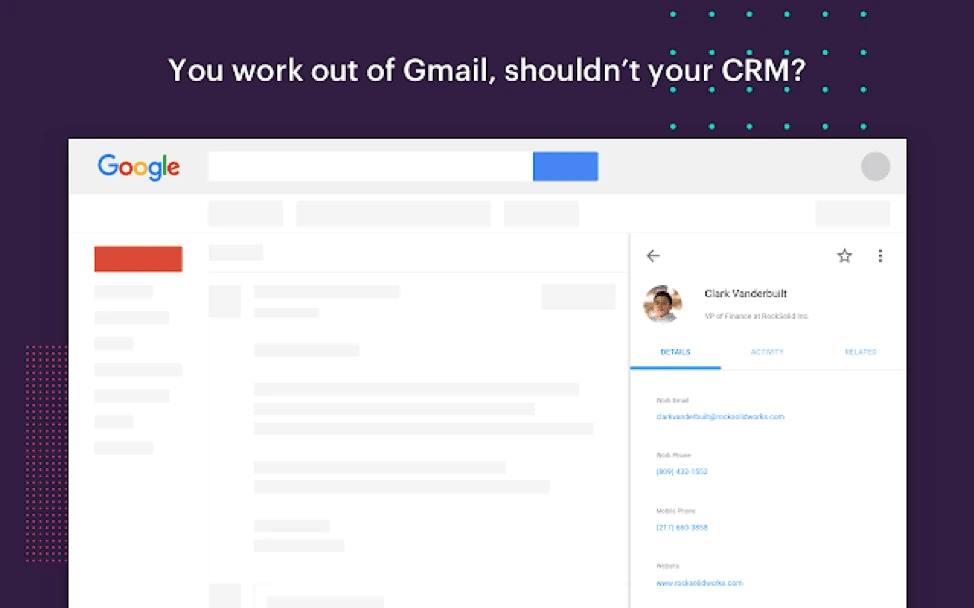
Pricing: From $19 per month.
2. Propertybase
If you need more from your CRM, Propertybase is worth investigating.
This real estate software tracks and manages leads, while also featuring a marketing center to manage email campaigns, real-time lead generation dashboards—and even syndications with platforms like Rightmove and Zoopla.
Granted, it’s more expensive than Copper’s CRM, but it could be the only software you need to manage your brokerage.
Pricing: From $79 per user, per month.
3. QuickBooks
QuickBooks is an accounting tool that real estate companies can use to track their finances. But, what makes QuickBooks different is the control it gives businesses without tons of financial knowledge, looking for more than just a spreadsheet.
You can track transactions, along with:
- Property descriptions—including floor plans
- Lease dates
- Current and market rent
- Due dates
- Appraisal values
Pricing: From $10 per month.
4. Placester
Every brokerage needs a website—that’s nothing new. But if you’re looking for a platform built specifically for realtors, Placester is fantastic.
Placester allows you to build modern, personalized websites with the aim of generating more leads for your properties. And, with several themes and lead capture templates to choose from, you don’t need a ton of HTML knowledge to create a strong website for your real estate company.
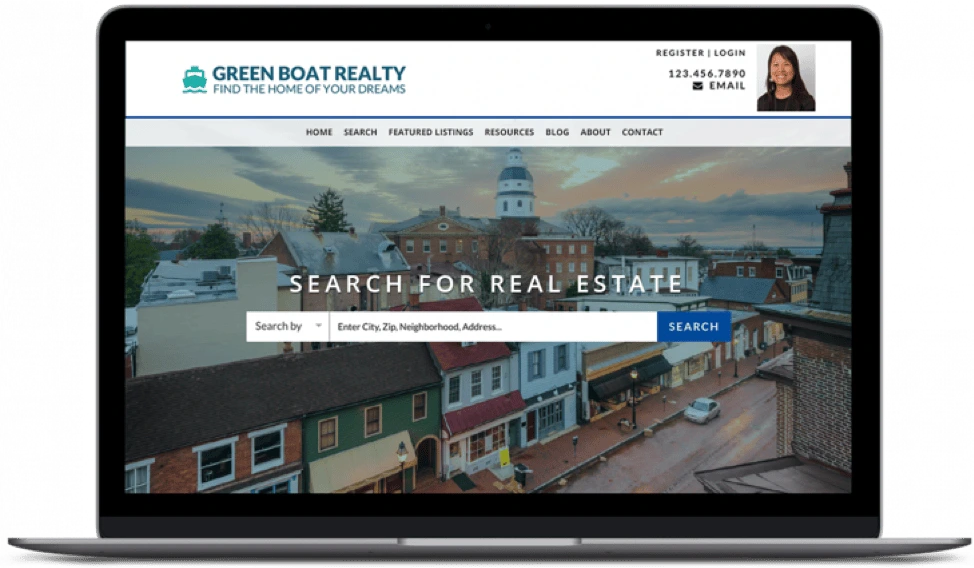
Pricing: From $99/month, plus $99 setup fee.
5. PropertyWare
Are you managing a handful of rental properties at your brokerage? Another real estate software you should add to your list is PropertyWare.
Designed to act as a “toolbox for single-family property management,” PropertyWare is a web-based software that allows realtors to track payments, create online portals for tenants and owners, and screens tenants to make sure they’re high quality.
The best part? It’s built by property managers—so they know what they’re doing.
Pricing: From $1 per unit, per month (minimum 250 units), plus an implementation fee of 2x the monthly subscription.
6. Commission Trac
Creating commission reports can quickly get confusing. That’s where Commission Trac shines.
A real estate platform that allows brokers to manage commission plans, invoices and agent distributions, Commission Trac “streamline back office accounting” and take away the headache from managing commission cuts.
They’ve also partnered with organizations like the National Association of Realtors to offer members 20% off their plans.
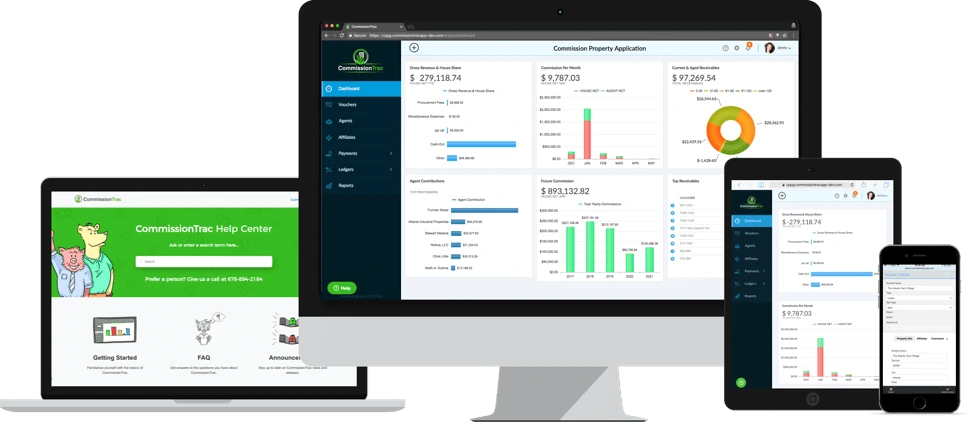
Pricing: From $45 per month, depending on how many agents are in your brokerage.
7. HelloSign
Don’t let paper documents take over your office. Ditch the traditional scanners and use HelloSign instead—a tool that allows your clients or tenants to sign documents electronically.
You can use HelloSign for a variety of electronic documents, including:
- Tenancy agreements
- Mortgage papers
- Offers to purchase
- Closing statements
- Real estate transfer tax returns
Plus, HelloSign documents are legally binding (and enforceable in court).
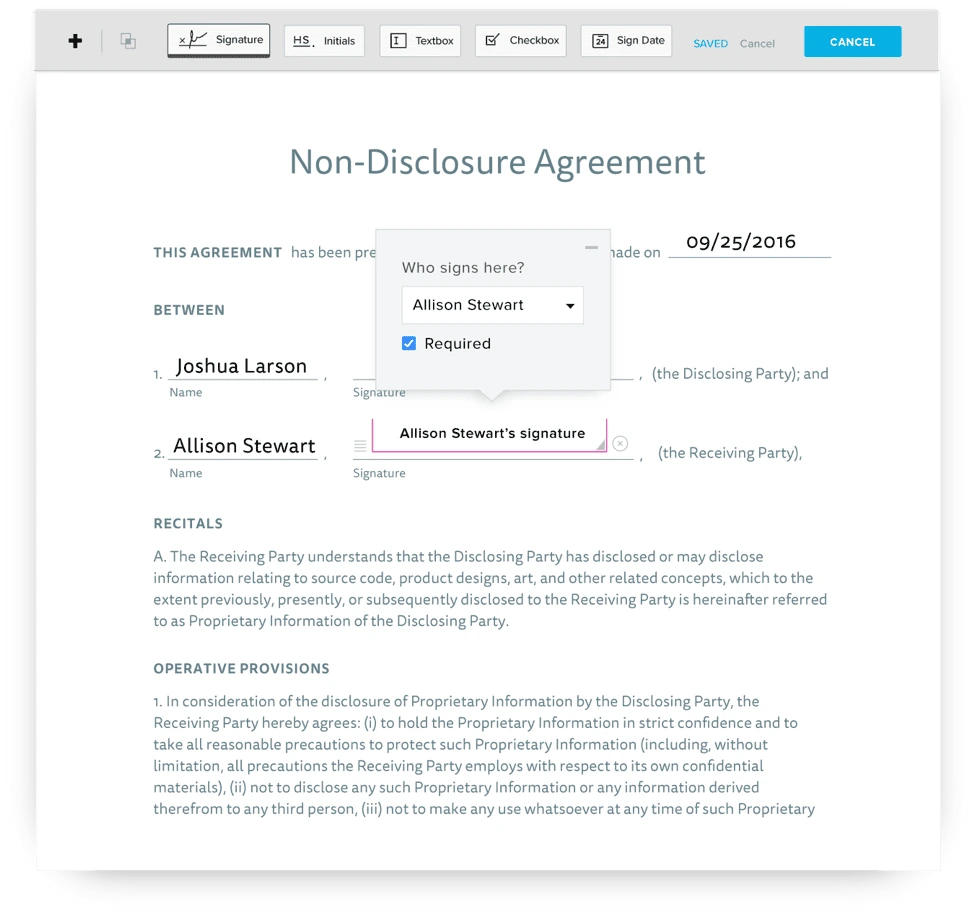
Pricing: Free for 3 documents per month; $13 per month thereafter.
8. ShowingTime
If you regularly schedule property viewings, ShowingTime is a software you’ll love.
ShowingTime is a real estate software that allows brokers to collect analytics and provide feedback on home showings. It also allows realtors to quickly schedule and confirm property showings, while helping to offer better customer service to their clients.
Nobody likes no-shows, right?
Pricing: Custom; demo required.
9. CityBlast
You’re likely familiar with marketing software that can help businesses supercharge their growth.
But, CityBlast is different to the rest. They focus solely on real estate businesses and have a live team who describe themselves as “social experts.”
They provide social media PPC campaigns to increase audience growth—meaning you could see more social followers, site traffic and hot leads if you’re enlisting their specialist help.
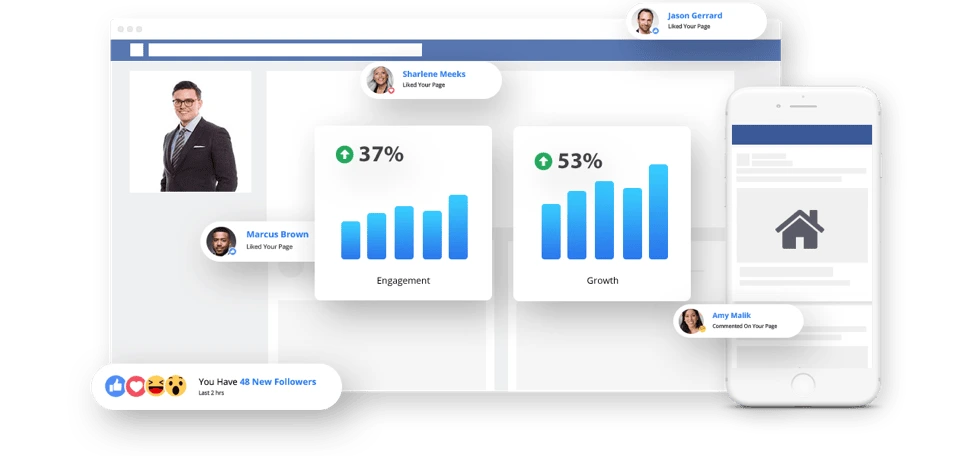
Pricing: From $83.25 per month.
10. AreaPulse
For more in-depth reports on your properties, it’s worth checking out AreaPulse.
In this web-based real estate software, you’ll find every metric you need to track the success of your brokerage, including:
- How long a property has been on the market
- 6-month price trends in the local area
- How many homes you’ve got for sale
You’re also able to send AreaPulse reports to your potential customers, giving them a solid understanding of the property market. Plus, with the ability to track open rates on these emails, it’s a great way to identify which subscribers could become hot leads.
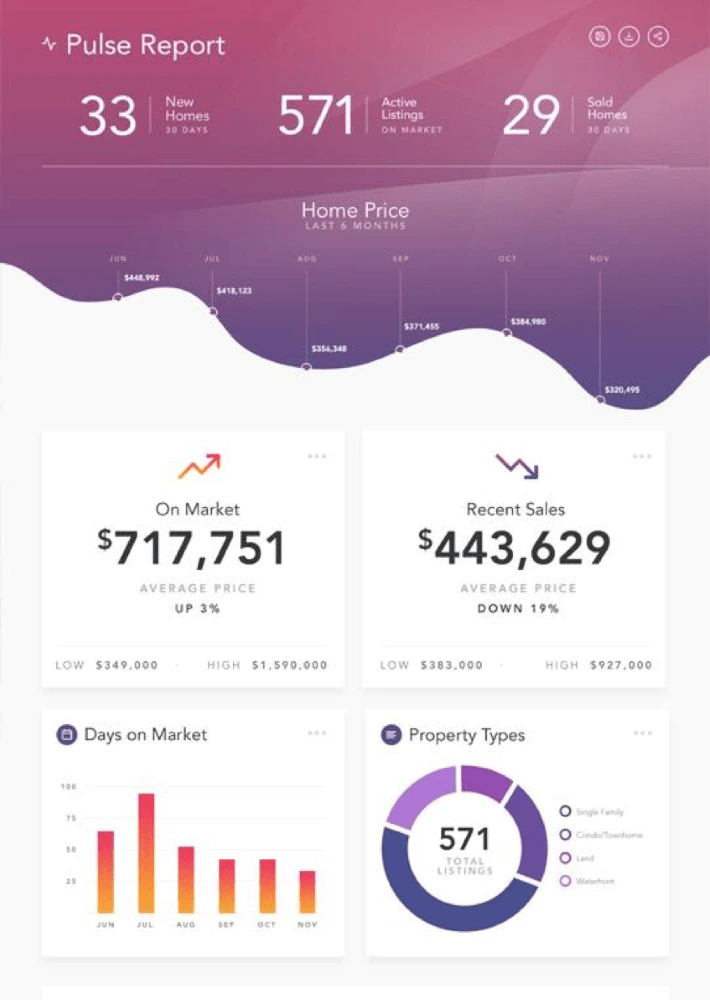
Pricing: From $49 per user, per month.
11. HouseCanary Value Report
Another incredible option if you’re looking to dive deeper into real estate analytics is HouseCanary’s Value Report tool.
They use data science, advanced software and predictive analytics to create the “most accurate automated valuation model”—meaning you get a full understanding of the local property market, forecast returns over the next three years, and set rent fees that are relative to the area.
Sounds awesome, right? (Spoiler alert: It is.)
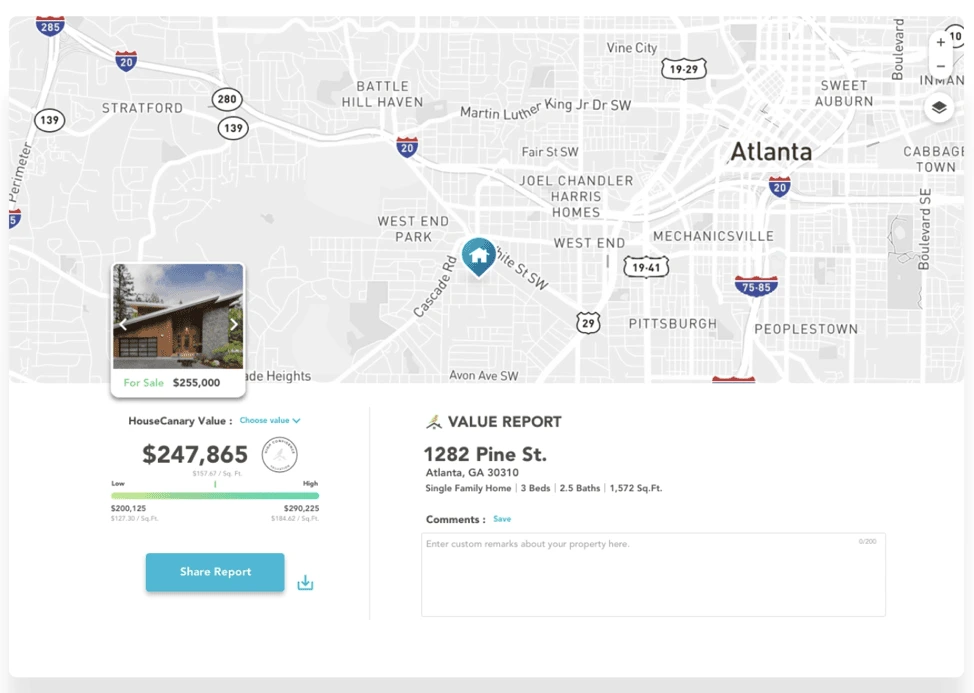
Pricing: Custom.
12. Lucidpress
…We couldn’t share a list of real estate softwares without including ourselves, right?
Lucidpress gives brokers a nifty tool to create branded real estate marketing material—such as PDFs, social media images and newsletters—in one web-based portal.
There are hundreds of templates to choose from, making it perfect for real estate businesses that need ahold of their branding campaigns, but don’t have a clue about graphic design.
(Considering that consistent branding increases revenue by 23% on average, you’d be mad to miss this off your list.)
Pricing: From $5.95 per month.
Key takeaway
Now that you’re well-equipped with the real estate software you’ll need to manage your brokerage, it’s time to start seeing results.
Remember to determine which tools are affordable, and start with tools you need (versus the tools you want). You don’t want to go broke in the process.
You’ll soon be experiencing increased productivity—we’re sure of it.
Get started with Lucidpress, the brand management platform for real estate. It’s perfect for brokerages of any size.
Since 2008, real estate has gone up by an incredible 11.4% and created a fantastic opportunity for real estate agents to sell more clients.
Millennials will quickly become over a quarter of the real estate market, and only 1% of those millennials didn’t search online while looking for a house. Just one percent.
Related: How to handle inbound real estate leads
The internet has forever changed the way real estate agents get leads for their business, and you’re definitely behind the curve if you haven’t optimized your website for lead generation.
How do you generate real estate leads online? In this guide, you’ll learn various methods for obtaining quality leads online and the secret to converting your website into a real estate marketing machine.
Let’s get started.
1. Social media
If you’re not a frequent user of social media, it’s time you got started. Most people have a Facebook account, and many are active users on Instagram as well.
Instagram in particular is a fantastic avenue for sharing high-quality images and videos of properties and advertising your latest content (e.g. blogs & newsletters) effectively. By engaging with different channels each day and adding value to others, you’ll begin building a devoted following online.
Lots of real estate agents don’t do social media because they lack time for it. But with tools like Buffer and Hootsuite at your disposal, you only need an hour to set up a whole week’s worth of posts. All that’s left is checking the comment threads and responding whenever you have a few seconds throughout the week.
Read more about social media for real estate: How to build a social media campaign for real estate
2. Website
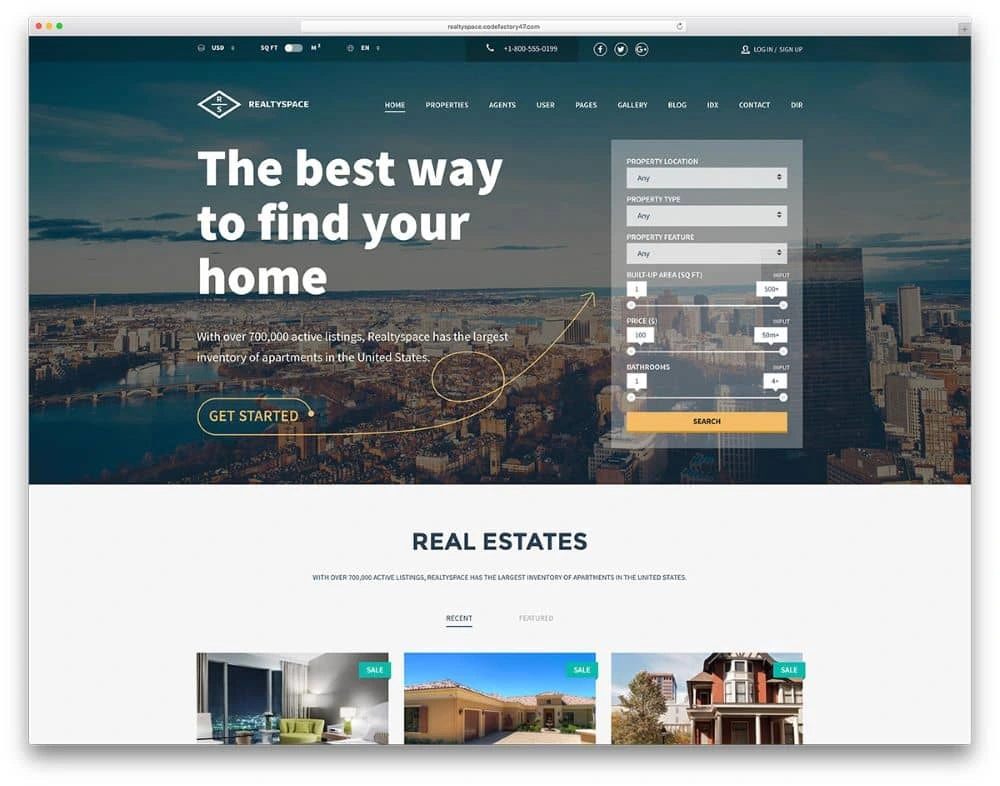
Source: Colorlib
If optimized properly, your website could be the foundation for attracting real estate leads online. It gives you the ability to provide value to your target market and help them engage with your brand.
Many real estate agents make mistakes in this area, and your website is not the place to describe your greatness in detail. Make your copy about how you’ll add value and better the lives of your customers.
An easy way to check whether your website is focused on your target market is to count how many times your site uses the word “we.” Customer-focused websites will use the word “you” more often.
3. Newsletter
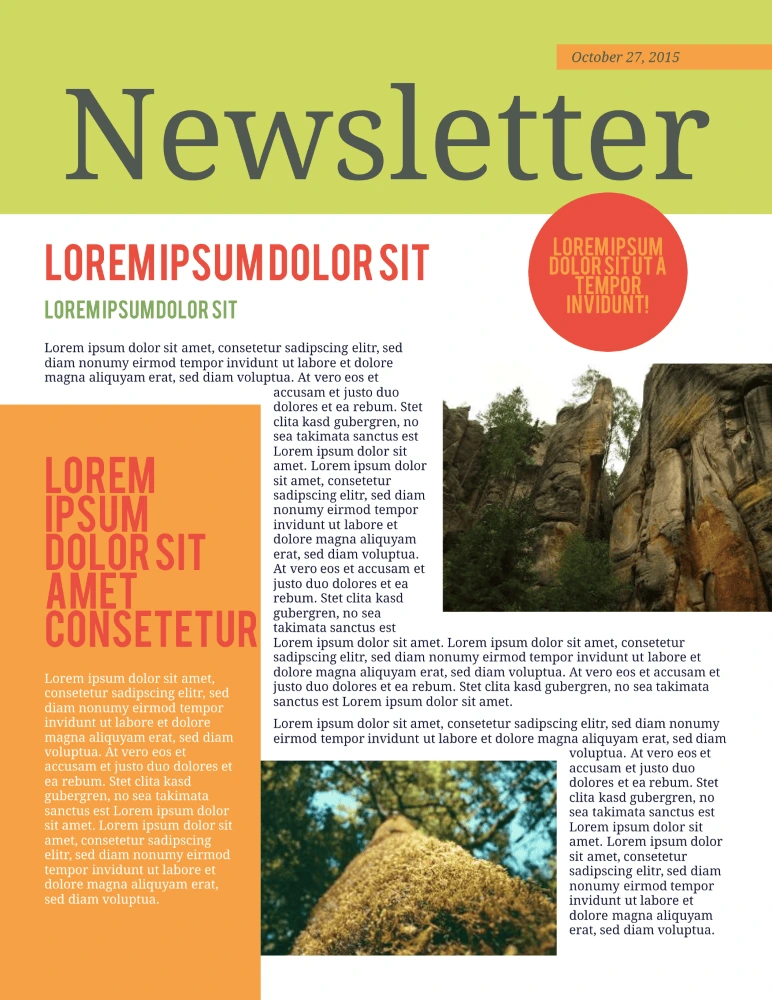
See more newsletter templates from Lucidpress
It’s always a good idea to keep your name top-of-mind, and a newsletter is a great way to do so. Newsletters can share real estate news, recent listings, and tips to deal with typical homeowner struggles—like preparing your house for the winter.
A newsletter is especially useful if your leads live in urban areas. Cities such as San Francisco, Los Angeles and Chicago are massive and busy, so it’s easy to miss out on events if you’re not paying attention. It’s also an excellent opportunity to inform subscribers about the latest news and events in their area.
Read more about newsletters: 13 best newsletter design ideas to inspire you
4. Blog
Blogging is one of the most popular and effective ways to generate leads online. But like any lead-generating tool, it has to provide great value to your target market. A blog post about the staff holiday party is not going to get the leads you want.
The best information to share with your target market is actionable. This could include topics like making a down payment, picking a lender, listing their home, and working with a real estate agent.
Free advice will grow your influence and make you a valuable resource—so when someone needs to sell or buy a house, they’ll think of you first.
Read more about blogging for real estate: How to use content marketing in real estate
5. SEO
The first page of search results has only ten slots. 33% of the people searching will click on the first result. 18% will go a step further and click on the second result. The further down the page you go, the fewer clicks there are—only 4.4% click on the sixth result.
That’s why every business wants to be on top. The lower you are, the harder it gets to attract your target market’s clicks.
The ideal SEO strategy is about finding the best keywords (and phrases) to target, then using them deliberately in your content to attract the customers you want. SEO powerhouse Moz has lots of free resources and tools to help you get started.
6. Video
If seeing is believing, then showing off the fantastic features of your properties is a surefire way to win converts—and there’s no better way to do that than with video.
Videos empower your potential clients to take a guided tour of your properties. They’ll be engaged by your content, but more importantly, they’ll be motivated to reach out for more information.
A video is far more than just a slick way to show off a property. On average, an online video converts 33% of leads. If you want a more captivating way to connect with your target market, video marketing is a great way to increase interest in your properties.
Read more about video marketing for real estate: How to create stellar videos for real estate listings
7. Influencer marketing
Connecting with others in your industry is always wise, and doing it online makes it easier than ever. You can share and amplify each other’s work through social media and comment on posts each of you publish.
Influencer marketing takes this one step further. It starts by figuring out who your target market is—specifically. Then, you can find influencers who are popular among the folks you want to target. By partnering with these influencers on advertising campaigns, you can reach wider audiences and attract more people to your brand.
Read more about influencer marketing in real estate: 5 influencer marketing strategies for real estate
8. Mobile optimization
Industry professionals often spend tons of time and money making sure their website is professional and easy to use… then forget to check how it looks on a smartphone or tablet.
Mobile search has surpassed desktop search, so it’s more important than ever that your website works with mobile devices. (Google is going as far as penalizing sites that haven’t created mobile-friendly layouts.)
Make the switch. Not just to protect your website from Google, but to impress customers who encounter your brand exclusively via mobile device. Aim for the same goals as your regular website: clear copy, attractive design and intuitive function.
Want to go even further with mobile? Read more about using mobile text messaging for real estate: 5 steps to build out your real estate mobile text messaging strategy
9. Referrals
When you start off as a real estate agent (or in any field, really), you won’t have a network. So, it’s up to you to build one.
As you begin to deal with customers, don’t forget to ask for referrals. Encourage them to share your name with others—make it easy and worthwhile for them to do so. Whether it’s to their friends, family or coworkers, advertising by word-of-mouth is powerful. People are more likely to follow recommendations from people they know than an anonymous review online.
10. Retargeting
Although we covered social media all the way at the beginning of this guide, we left out one element that deserves its own section: retargeting via Facebook ads.
Facebook ads are not a popular method of advertising in real estate circles, despite how high the ROI can be. Here, retargeting simply means that people who have shown interest in your brand will see your ad again. This “interest” is measured by actions such as reading your blog posts, clicking on one of your ads, or even signing up for your newsletter.
Your conversion rate will improve if you target people who want what you’re selling. People who are actively interacting with your brand are more likely to buy than those just scrolling through their feeds. Retargeting keeps your brand top-of-mind for the folks who matter most.
Key takeaway
Leads don’t just magically appear in your inbox. You need a strong lead-generating strategy that helps you cultivate interest in your brand and set you apart from the competition. These tips should get you on the right track to generating real estate leads online.
Hungry to hear about the best marketing practices for real estate? Hop over to our real estate marketing guide for more ideas & inspiration.
Starting a real estate business is an exciting step in any real estate agent’s career. However rewarding running your own real estate business may be, though, it’s not without its difficulties. Starting your new small business on the right foot will offer you a solid foundation to build upon and put you ahead of the game.
Related: Guide to an effective real estate listing marketing strategy
In this article, we’ll provide vital tips on how to expertly start your real estate business and set yourself up for success.
1. Complete requirements to become an agent
If you’re not already an active real estate agent, you will have to meet some requirements to become one. Start by following the qualifications to obtain a real estate license in your state. Your local real estate bureau will be able to provide you the information you will need. Also bear in mind, you may be required to work for a brokerage the first few years after obtaining your license. If you want to use the term REALTOR®, you will also need to join the National Association of Realtors. Members of NAR enjoy many benefits including access to their MLS and content and trainings relevant to the real estate industry.
2. Lay out your personal goals
Your new venture offers the perfect opportunity to reevaluate what you want from your real estate career. Perhaps you’re starting this new real estate company so that you can set your own hours or take time off at your discretion. Maybe you’re aiming to retire by 60 or pay for a family vacation each year. Defining your desires will help you stay focused and motivated as you work to expand your real estate business.

Source: Pikwizard
3. Determine your business objectives & values
Now is the time to set your business aspirations and define the ethos of your brand. Creating a business plan will double your chances of success. What are your financial goals, and what steps will you take to accomplish them? What are your values? What sets you apart from your competitors? Document these important cornerstones of your real estate business and use them to guide you in your future decision-making. Once you have these core decisions made, start creating visual identity for your real estate business. Create a logo, select brand colors and choose a font.

Source: Pikwizard
4. Find the right team
Starting a real estate business is rarely, if ever, a completely independent task. Even if you’re a solo operator, you may choose to enlist a marketer to increase your exposure, or a financial advisor to ensure your hard-earned money is invested wisely. Maybe you’re going into business with other real estate agents or have decided to hire an assistant for extra help around the office. Whatever your circumstances, ensure that the people you surround yourself with share your vision and will work hard to see it through. Visit this blog post for a more in-depth look at real estate recruiting.

Source: Pikwizard
5. Implement a comprehensive marketing strategy
A solid marketing strategy will spread the word about your new business and capture the attention of prospective clients. Keep your branding consistent across all marketing channels, and use messaging to communicate your brand values.
Consider using marketing automation software to bolster your efforts. After all, “67% of marketing leaders currently use a marketing automation platform” and “80% of marketers using automation software generate more leads.”

Source: Pikwizard
A thorough guide to marketing your real estate business can be found here, but here are some essential components to keep in mind.
- Create a website. In today’s digital age, it’s absolutely essential that your real estate business have a strong online presence—and this begins with a website. Your website will be used to introduce yourself and your business, post current listings, share client testimonials, provide contact details, direct visitors to your social media profiles and host your blog. It’s important that your website is professional and user-friendly, so work with a web designer if necessary.
- Social media. Social media is one of the greatest tools an agent has in their arsenal. Using outlets such as Facebook, Instagram, Twitter and LinkedIn will give you a direct link to prospective clients and the greater real estate community. Be sure to post engaging content regularly and keep your posts true to your brand. While it may be tempting to post a stream of real estate listings, provide other informational content as well such as information about the company you work in or advice for purchasing real estate for the first time. This post offers an in-depth guide of social media in real estate.
- Blogging. Having a blog is a great way to attract more visitors to your website and establish yourself as a thought leader in the field. Your blog posts will also give you interesting content to share across social media. The topics you choose to blog about should be relevant to potential real estate buyers and specific to your location when possible. Blogging frequently and using SEO-friendly titles & keywords will increase your exposure and result in more leads. In fact, a recent study showed that “companies that published 16+ blog posts per month got about 4.5 times more leads than companies that published zero to four monthly posts.” Learn more about content marketing in real estate.
- Paid advertising. Consider investing in paid advertising in order to target your prospects wisely. Google and Facebook ads are especially effective and there are options to suit every budget. On average, businesses make $2 in revenue for every $1 they spend on Google Ads.
- Email marketing. Now is the time to start building an email database and sending regular updates to your list. It’s been proven that “77% of people prefer to get permission-based promotional messages via email (versus direct mail, text, phone or social media),” making email one of your most valuable marketing tools. Learn more about real estate email marketing and grab a free template.
- Build your offline collateral. While online collateral is essential, so are your offline offerings. This includes things like business cards, stationery, brochures, flyers and signs. These are especially important for realtors, because they will be seen repeatedly by clients and prospective clients. As always, your branding should remain consistent across every outlet. It’s critical that you maintain a professional image at all times, and a brand templating platform can help you accomplish this.
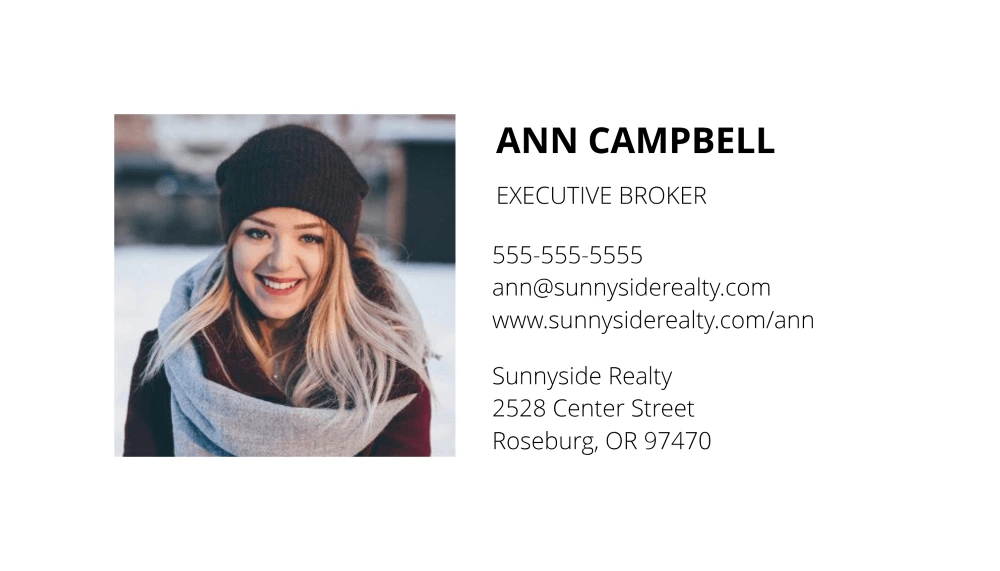
Source: Lucidpress
6. Host a launch event
Hosting a launch event for your new real estate business is an excellent way to introduce yourself to the community. According to Bizzabo, “Most (41%) marketers believe that events are the single-most effective marketing channel over digital advertising, email marketing and content marketing.”
A well-crafted event will create buzz around your real estate brand, allow you to reach a wider audience, and start your business off with a bang. Be sure to publicize your event across social media and ask your friends & family to help spread the word. Invite relevant business owners, influencers and news outlets.
An event also provides the perfect opportunity to meet and get to know your prospects. Real estate is a personal business, and connecting with potential leads face-to-face will set you apart from the competition.

Source: Design Wizard
These tips will help launch your real estate business successfully and allow your new venture to flourish. Start your business on the right foot by following our advice, and turn to Lucidpress for all your custom marketing materials. We wish you the best of luck on your new & exciting journey.
Your brand matters. Learn how to protect and elevate your real estate brand in this branding essentials guidebook.
You likely already know that a logo is an important part of any business’s branding. Not only does it make your modern real estate company stand out from the competition, but a solid logo can attract and win over new customers. That’s what we’re always aiming for, right?
Related: Real estate branding—a comprehensive guide
But, it’s tricky to design a custom logo for your real estate firm. You’ll need to think about the colors, fonts and shapes you’re using—not to mention arranging each individual element to create an impressive design.
So, we collected eight of the best real estate logos to help inspire your own.
What makes a good real estate logo?
The logo you’re creating for your real estate agency is one of the first things you’ll need to nail. But before we share some of our favorite modern real estate logos, let’s chat about what makes a logo so great.
A strong logo usually is:
- bold
- unique
- easy to understand
Yet above all, the logo you’re creating for your real estate company needs to be on-brand. There’s no use in having a bright and colorful logo if your website, social media channels and letterheads are black and white.
Your audience won’t understand it, and you won’t see the 23% average revenue increase that businesses with consistent branding experience.
(Remember, that’s the aim of a logo: to make your business stand out.)
8 awesome real estate logos to inspire your own
You don’t have to start from scratch when you’re creating your own real estate logo. Take a look at these examples, pick out the ideas or concepts you like, and find a way to work them into your custom logo.
However, we’re coming at you with a word of warning: Please don’t directly copy these logo examples. The best logos are unique, innovative and stand out from the crowd, so take these ideas and try to put your own spin on them.
1. Smith Mountain Homes
First up is this beautiful logo from Smith Mountain Homes.
You can quickly understand the type of homes they sell, right? And it’s not just because the word “mountain” features in the brand name; they’ve used graphics to signal the type of property they sell.
Granted, the design and font choices are simple—but that’s often the best way to create a memorable logo.

2. Cabo Cribs
If you’re looking to buy property in Cabo, I’ll bet Cabo Cribs’ logo catches your attention.
Similar to the real estate logo above, this design is simplistic, but it doesn’t scrimp on the essentials of a good logo. It’s easy to understand, elegant, and has a small graphic that makes it obvious they’re selling homes.
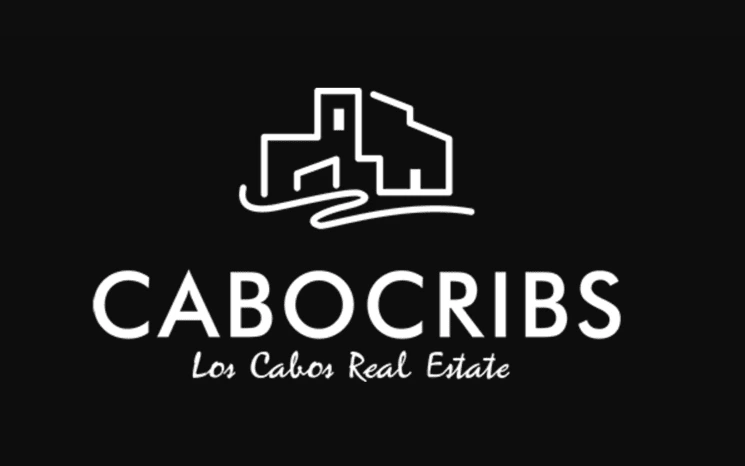
3. Williams & Williams
If you’re in the market for a luxury property, you’ll love Williams & Williams’ logo.
Take one glance at this logo and tell me what you interpret. It’s gold-themed, has elegant writing, and shows palm trees with the properties they’re managing. It ticks one huge element of a great logo: It’s perfectly on-brand for their commercial real estate company.

4. Compass
Who said a logo had to contain words?
Think of the world’s most recognizable logos. McDonald’s, Nike or Adidas will likely make their way onto that list—and none of them have a brand name in their logo.
Real estate firm Compass looks like they’ve drawn inspiration from those huge brands with their word-free logo. Although you can’t clearly see they’re selling properties, it’s a great way to make their audience stop and pay attention. After all, what are realtors for if not providing their clients with valuable guidance and direction?

5. Blue Key Property Management
I’ve included this logo concept for Blue Key Property Management here purely because it’s so simple, yet so effective.
You might’ve seen by now that many real estate logos contain property-related graphics. But instead of taking the standard route of a house, this firm opted to use keys—a factor that helps them stand out from the competition.
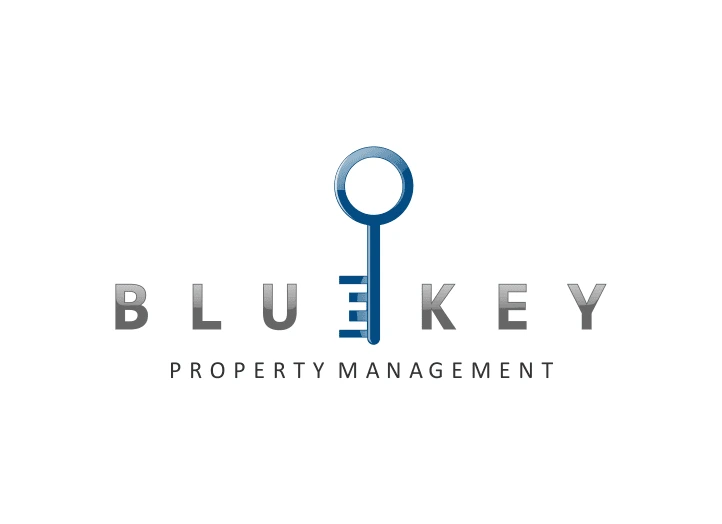
6. Delicious Real Estate
A simple—yet effective—way to build your real estate logo is to think about your buyer personas and their pain points. What are they looking for when they’re purchasing or renting a home from your firm?
It seems like Delicious Real Estate think it’s a reasonably-sized home. That’s why they’ve portrayed the situation their customers are usually stuck in through their logo.
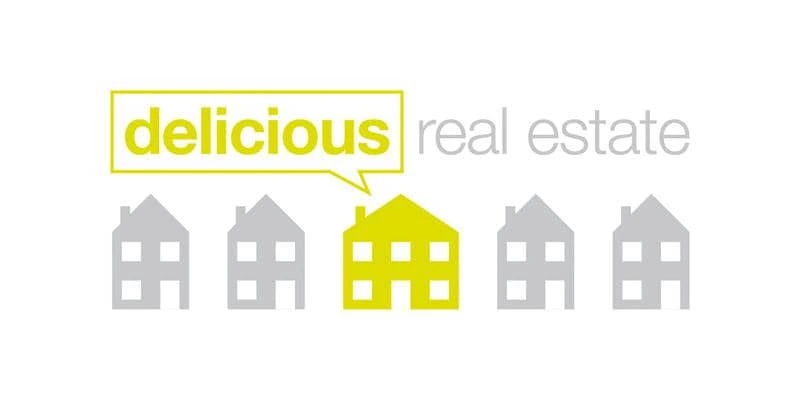
7. Crown Real Estate
Remember how we mentioned real estate logos should be simple and easy to understand? Take a look at Crown Real Estate’s logo, which does exactly that while using simplistic fonts, a black-and-white color scheme, and a basic crown icon to match their brand name.

8. Live Dubai
The final logo on our list comes from Live Dubai.
Much like the other real estate logos we’ve listed, this one is simple. But, what we really love about this design is the way lettering is used to create an interesting logo that’s totally unique to their brand name.
This gives them two options: use the graphic & text together as their logo or crop the image just to use the lettered graphic.

How to create your own real estate logo
Feeling inspired and ready to start designing a new logo for your real estate company?
You don’t have to hire an expensive graphic designer to create a custom logo design. There are thousands of templates you can customize, making a DIY logo the best way to create a professional brand for your real estate business—even if you’re on a tight budget.
However, if you do have some cash to splash on a fancy real estate agency logo, hiring a graphic designer is a great way to make sure your logo is unique. …Just make sure they’re sticking with your brand guidelines.
Key takeaways
As you can see, there are tons of incredible real estate logos that can inspire your own.
Remember, the most effective logos are unique, bold and easy to understand. And while each real estate logo design we’ve listed here ticks those boxes, you’ll need to add your own spin to each design when you’re creating your own.
Ready to start exploring your new brand identity? Try creating a few logo variations in Lucidpress, using your brand colors.
The long tentacles of coronavirus have touched every aspect of our lives, and especially so for the mortgage industry. It’s not clear where the housing market is going to end up, but right now things are busy.
For consumers, there’s the allure of rock-bottom interest rates, while many people are also facing new, stricter standards for loans. And others are apprehensive about making any moves, literally and figuratively, when the economy is so volatile.
It’s predicted that mortgage lending will reach a 14-year high in 2020. With the surge in refinances, you may find yourself busier than ever. So this is good news… right? We’ll take our silver linings where we can get them.
Amidst the hustle and all the uncertainty, you may be looking for ways to reassure clients, build business, set yourself apart, and work efficiently so you can handle what lies ahead. We’ve thrown together our best tips and ideas for mortgage marketing to help you navigate that new normal.
Behind every loan officer, there is a strategy
Keep these four things in mind as you polish your mortgage marketing strategies.
Be human
Buying a house is enough to make anyone anxious… combined with the stress and unknowns of the current world climate, you’ve got a recipe for, well… even more stress. Doing your best to be as real as possible (aka “human”) can make your clients feel a little better about navigating the mortgage market during what feels like the apocalypse.
Research shows that over 75% of people expect a business to understand their needs and situation. Show potential clients that you can empathize with their worries by simplifying the mortgage process as much as possible. Review your marketing materials and see where you can decode or simplify the language.
But what does being human mean in the context of marketing? You may be wondering, “Aren’t I already human?” Good question. Being human simply means, speaking plainly and communicating with clients in the same way they communicate with you. It means not sounding like a marketer or loan officer. For example, instead of focusing solely on numbers and low interest rates, translate that to what it means for the client. Maybe “Save X% on your monthly payment,” becomes, “Now you can put $X more in your savings account or toward a new car.”
Ideally, all of your communication —everything from the way your company messages itself to how loan officers speak with clients — should be presented in a way that’s accessible, compassionate and personable.
Leverage your visual content experience
Make sure you’re paying attention to your appearance, so to speak. Unfortunately, people do notice the inconsistencies that pop up across your website, social media and printed materials. A study from Salesforce noted that 75% of consumers have come to expect consistency from businesses and brands “with 73% likely to switch brands if they don’t get it. Customer loyalty — and attrition — is determined by every experience. Predictive, anticipatory service is increasingly the norm.”
With large brokerages like Rocket Mortgage becoming more familiar to consumers (and making the market all the more competitive), smaller operations need to throw some resources into branding and customer experience. Maintaining a consistent brand, in both design and voice, can reassure clients of your quality and trustworthiness, which helps your organization stand out in a crowd.
Evaluate where brand inconsistencies are stemming from. Do you need to update your brand style guide? Are brand assets easily available to everyone? Are brokers creating off-brand content? Consider solutions like design templates for brokers that have branded elements already in place. Empowering everyone at your organization to make their own, on-brand content can cut down on the noise and inconsistencies you’re seeing across marketing channels.
Get cozy with digital marketing
Putting together a solid digital marketing plan is key for generating new leads. And social media will offer the most bang for your buck.
We recommend building a solid content plan for LinkedIn — this is where you’ll find real estate agents, brokerages and builders that you can connect with to grow your business. Facebook can also be a great platform for reaching homebuyers — but LinkedIn is the best place to expand your circle and show other people in the industry what your business is about.
Social media is designed for building community, and it’s an ideal place to connect with new people. Taking small steps like reposting listings from agents you’d like in your network and commenting on content that’s interesting to you can help your business grow a healthy following.
Have you helped anyone land their dream home lately? Posting about client success stories makes for feel-good content that people like to see in their feed. Keep the content you post diverse and engaging with a smattering of home-buying tips, mortgage knowledge, property listings, industry news, and anything else that piques your interest.
Automate where you can
Staying on top of digital marketing is no small task — especially if you haven’t got a team to help. Automation could be your best friend, and luckily, there’s not much you can’t automate these days.
- Email — Emails can be easily automated, and it would be a great time to do, say, an email drip campaign about refinancing. Over the course of a few emails you could talk about the benefits of refinancing right now and what the process entails from start to finish. Look into a tool like Mailchimp, which is designed to help smaller businesses automate email campaigns and reach customers without doing much heavy lifting.
- Social media — You can also set up your social media posts to be automated by a tool like Buffer. Automation platforms like this will post content for you based on a schedule you set, and they even have tools that analyze how your content is performing. Good analytics can be helpful if you feel like you’re not getting enough engagement or want to tweak your social strategy.
- Content creation — Certain design platforms (like Lucidpress ?) also offer data automation, which can be invaluable for customized marketing campaigns. Data automation lets you connect to spreadsheets or even your MLS — then you can quickly upload a bunch of information to marketing materials as needed. This is an easy way to create custom collateral for your clients that won’t cost you any extra time or energy.
Take a look at your current marketing campaigns and see what you can automate. Automation will free up your time so you can focus on more pressing things or even brainstorming your next big marketing venture.
However you decide to implement mortgage marketing ideas for the new normal, be sure that your strategies support any long-term goals you might have for your company. Conduct an audit of your existing business continuity plan to see where any of these ideas fit in. Alternatively, it couldn’t hurt to create a new business continuity plan if yours might be a bit outdated. And, if you want to do a deeper dive on how you can strengthen your brand, check out our free ebook on brand consistency and how it impacts your ROI.
Social media can help real estate agents find a wide audience, in the right area and at the right time.
In fact, according to the National Association of REALTORS 77% of real estate agents use social media. Facebook is by far the most popular platform in real estate, followed by LinkedIn and Instagram.
Related: Real estate marketing guide
Even with limited resources, savvy real estate agents can build meaningful relationships and earn more clients with social media.
How do you do it?
The sheer array of social media platforms and real estate marketing techniques seem overwhelming. Here are seven and a half practical tips to get you started in no time.
Social media for real estate tip #1: The basics
If you are already set up on social media, go ahead and skip ahead to the advanced tips below.
Facebook for real estate
To get started, set up a business page on Facebook. This is more professional than posting to a personal account and gives you access to useful business features such as page analytics and the ability to promote posts to your audience. Posts with images and video perform best on Facebook, so be sure to use compelling visuals with every post you create.
The Facebook algorithm favors posts that get a lot of engagement, so ask questions to drive comments or share content your followers will enjoy such as an upcoming local event, so they like and share it. If you’re just getting started and don’t have a large social media following yet, holding a contest to bring awareness of your real estate page is a great way to build up your follower count.
Instagram for real estate
Instagram is quickly becoming one of the most popular social media sites. As a visual platform, every post will need to be visually compelling. Use the caption that goes with the photo to provide additional details and include your contact information. A single Instagram post can be made up of a series of images, making it a great way to show photos of a new real estate listing.
LinkedIn for real estate
Update your personal profile and if you are running your own business, create a page for the business as well. LinkedIn provides a great opportunity to network with other real estate agents, connect with real estate brokerages and connect with current clients.
Social media for real estate tip #2: Start two-way conversations
A staggering 94% of millennial homebuyers are taking their search online. This creates incredible opportunities for real estate agents to connect with them there—but only if they truly understand their audience’s motivations.
It’s tempting for real estate agents to promote their business and new home listings relentlessly on social media. After all, isn’t that what those platforms are for?
Not exactly. For potential homebuyers, constant, in-your-face promotion has minimal appeal. If they wanted endless advertisements, they could just flip open a magazine or turn on the TV. Treating them this way shows a fundamental lack of understanding about your target audience.
The vast majority of potential homebuyers are searching for information. They have questions. If they’re considering buying for the first time, they’re probably intimidated, too.
Savvy real estate agents use social media to walk everyone through the process, creating stronger bonds than the constant sales pitch approach. Instead of just posting endless promotional content (a one-way broadcast), you open up two-way conversations. The audience becomes a key creator of the shared experience.
This takes on many forms. It might be searching Twitter hashtags and offering real estate advice to those in your local area. Tomorrow it might be hosting a Q&A session on Facebook Live. Next week it might be something as simple as asking a question in your newest listing photo caption on Instagram. Whenever you can, invite your audience to participate in the conversation.
Yes, you can still find opportunities to promote your real estate listings. But, a commitment to being relentlessly helpful builds trust and authentic relationships.
Social media for real estate tip #3: Choose your social media platforms wisely
Social media is fast-paced, chaotic, and changing constantly. It’s easy to get overwhelmed by the sheer number of platforms.
Real state agents new to social media might feel the pressure to “be everywhere.” Pressed for time already, they drive themselves crazy trying to maintain a presence on a dozen different accounts.
This approach actually leaves them worse off than before. Because they’ve spread themselves so thin, it’s impossible to get the traction needed to build an audience on any platform.
What could you do instead?
Start by taking a deep breath. Acknowledge there are tons of platforms out there—and a lot to learn. And accept that you’ll see the best results for your real estate business by focusing on just a few right now. Begin the journey with proven social networks like Facebook, Twitter and Instagram.
Which platforms deserve the majority of your focus? A lot depends on your audience. Beyond the overall popularity of the platform, consider where your target market spends their time online. You wouldn’t want to launch a Snapchat strategy when trying to sell retirement condos—the demographics there skew too young. If you’re selling commercial real estate, consider connecting with successful professionals and industry organizations on LinkedIn.
Do some preliminary research to pinpoint where your audience is most engaged. Other real estate agent’s and brokerages accounts can be a great place to start. Using those insights as a guide, narrow your focus to a few platforms as availability allows… which brings us to the next point.
Social media for real estate tip #4: Post consistently (and strategically)
A successful social media for real estate strategy is a lot like a successful relationship-building strategy in real life. You need consistent contact—and interactions that provide value and motivate people to keep coming back.
The goal: create enough interactions for your audience to get to know you as a real estate agent without overwhelming them to the point they tune you out.
This is a delicate balance to maintain, but the good news is it’s something you can always adjust as you go. Feedback from your networks (whether you’re gaining or losing followers, their engagement, etc.) will tell you if you’re headed in the right direction.
You can use social media software to schedule posts beforehand. This gives you the freedom to meet with clients, work open houses, and attend closings all while building your presence automatically. It’s easy to post multiple times a day this way.
Posting frequency is one thing, but you also have to consider the nature of the content itself. Most content breaks down into three different types:
- Time-sensitive/promotional. These posts advertise new properties on the market, open houses, or your brand in general. Think of listing photos, tweets urging prospects to give you a call, and virtual tours with Facebook livestreams or 360-degree photos.
- “Evergreen” how-to or informative. This content answers questions, shares tips, or finds alternative ways to provide value. It’s just as valuable a year from now as it is today. This could be decorating tips, a checklist to help you see how much house buyers could afford, or cool DIY renovation project ideas.
- Fun or entertaining. This content might not be directly related to real estate, but it’s a great way for you to showcase your personality. It might be a review of a new restaurant in town, a heads-up about traffic on the way home, or even those viral cat photos. Social media just gets prospects in the door. It’s your personality and expertise—real-life relationship skills—that will close the deal.
Understand the goal of each post you make, and mix things up to engage your audience and keep them coming back.
Finally, remember that there’s no need to create all this content yourself. Supplement your own efforts by sharing, retweeting or linking to other great content in the real estate industry. Your clients are a great content source—whether it’s sharing a quote from their testimonial or a photo of them toasting a new home.
Social media for real estate tip #5: Incorporate storytelling
Every great real estate agent knows how to tell a compelling story. Include that storytelling element in the social media content you create.
Some examples:
Talk about the neighborhood. When posting a new real estate listing, do more than talk about the price and features of the home. Create a compelling story by including details about the neighborhood. Help the potential buyer picture what it would be like to actually live in that home.
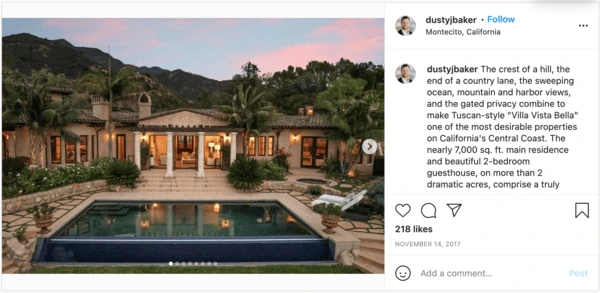
A post shared by Dusty Baker (@dustyjbaker) on Nov 14, 2017 at 10:46am PST
Include client testimonials. Ask happy customers if they’d be willing to create a video testimonial. Testimonials make compelling stories that help build trust with your audience.
Share milestones. On LinkedIn, share milestones of your real estate business. This could be anything from 10 years in business to updated branding or a new website.
Using storytelling in your social media campaigns will help drive greater engagement and build trust with your audience.
Social media for real estate tip #6: Use great, on-brand visuals
Social media has transformed the way realtors and agencies connect with potential buyers and clients. Because of the visual nature of house shopping, it’s easier than ever for people to go online and find examples of their dream homes.
Ideally, this should make real estate marketing faster and easier… but unfortunately, that’s not always the case. If you’re unfamiliar with Photoshop or other desktop publishing software, it can be difficult and time-consuming to create content specially for each social media site.
Instagram is a completely visual platform, which makes it perfect for marketing real estate. Photos are nice to have, but it can leave buyers confused as to what to do next—”Is this property for sale or just for show?” they might be wondering. By using this square photo collage, you can show off multiple views of the property and guide folks toward the next step: contacting you for a walkthrough or an offer.

Speaking of visual platforms, Pinterest is a haven of gorgeous home ideas, which makes real estate a natural fit. Pinterest users build boards to house (heh) their pins, all of which come from various sources. It’s easy for your name or website to get lost in the shuffle—unless your images themselves are clearly branded. That’s what makes this perfectly sized Pinterest template a cut above the rest. The majority of space is reserved for eye candy, but all the important property details are right there, too.
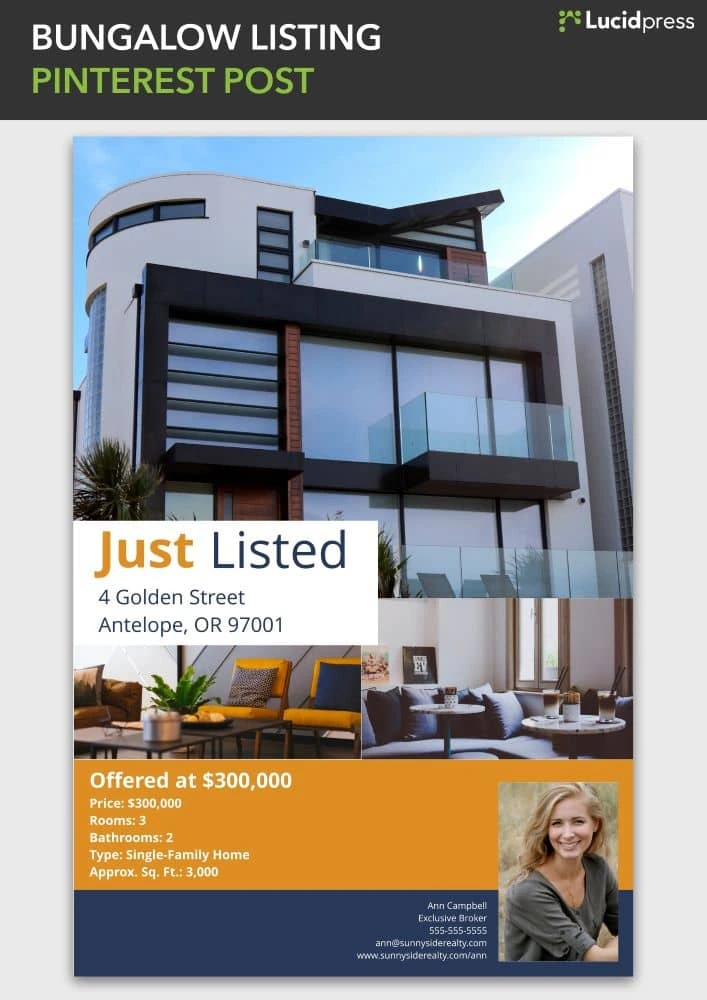
When you want to get a new listing out fast, no platform is better than Twitter. Not only can you keep your followers in the know, you can also target new audiences with paid promotion to get the most mileage. Because things move so quickly on Twitter, it’s important to design posts that are easy to digest. This template is oriented horizontally; it’s compact and looks great on both desktop and mobile.
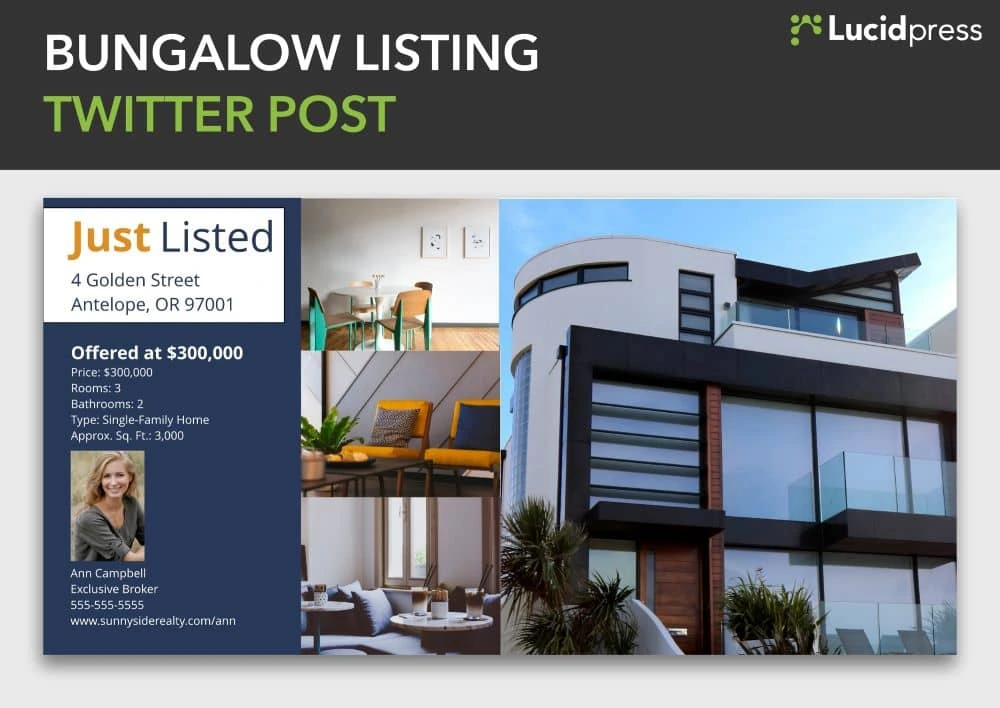
Social media for real estate tip #7: Remember your past clients
Social media is a great tool for realtors to build relationships and land clients. But, that’s only part of its appeal. It can also help maintain relationships you’ve already developed.
What happens when those closing papers are signed? Clients feel a rush of adrenaline, but after a few months, everyday life creeps back in. An incredible 70% of homeowners can’t even remember their real estate agent’s name one year after closing.
It’s a shame to have those relationships slip away after you’ve spent so much work building them. With a little social media love, it’s much easier to maintain them. That way, when clients are ready to move again or recommend a realtor to family or friends, you’ll be the first person who comes to mind.
How can you do this on social media?
Release a steady stream of that evergreen content we mentioned earlier. Brainstorm all the things you wish you knew when you moved into a home. Is it design inspiration? Checklists to get organized? Ways to prepare for the winter or save money on utility bills?
You can also broaden your content from real estate itself. Now that your client has moved, they’re living, working and integrating into the community. They might be interested in that new restaurant down the road. Or the best summer camps to send their kids. You can become their go-to source for all things local.
Social media for real estate tip #71/2: Measure and keep learning
You’re sending emails to clients, working open houses, and putting out yard signs. (Not to mention trying to keep up with your own personal life.)
You don’t have endless hours to pour into social media that isn’t paying off. How are your tweets performing compared with your Pinterest posts? Should you be posting on Facebook or focusing on Instagram?
These are the questions that can frustrate you to no end. Instincts might give you some indication, but measuring will let you know for sure.
Fortunately, it’s never been easier to collect data on social media performance. It’s easy to see which posts get the most engagement in terms of likes, retweets and comments. But, if you’re looking to see what’s really moving the needle in terms of sales, why not create unique landing pages for each platform?
A landing page simply directs visitors whenever they’re interested in contacting you, seeing a new listing, and so on. Tailoring them for each social media platform allows you to track where leads come from. You can also find out a lot more about each user’s interactions with your brand and their path to becoming a client.
Keep an eye out on which platforms, campaigns and topics perform best. As long as you keep tracking your analytics and tweaking your strategy, it will gradually get more effective. This optimization process never ends, but the payoff increases over time.
Over to you
Social media has become an essential piece in every realtor’s marketing toolkit. Thankfully, it doesn’t have to be overwhelming anymore. Apply the tips above while launching your real estate marketing strategy, and you’ll build an impressive audience, engage them, and bring in more business.
Kickstart your next social media campaign with our free templates for real estate.
If a single picture is worth a thousand words, then a video is worth an entire book. Buying or selling a house in the digital age requires digging into the high-tech toolbox to reach your customers. A simple well-crafted video can function as a living billboard for real estate agents and home sellers alike.
Related: How to create stellar videos for real estate listings
Real estate video marketing is mapping previously uncharted territory for reaching customers looking to buy a house. YouTube isn’t just for watching funny cat videos. It’s also an effective avenue for quickly getting your message to a wider audience. YouTube is now the second-largest search engine (behind Google). This means a real estate agent who uses video to sell properties will draw in a much larger crowd than one who relies on marketing the old-fashioned way.
Selling real estate is all about getting visual. Prospective buyers want to tour a house before purchasing, so they can see how everything looks both inside and outside. Real estate videos can be their eyes and ears for anything from virtual tours of a house to neighborhood guides.
Guidelines for using video marketing in real estate
Making videos doesn’t require complex skills, thanks to the abundance of smartphone apps designed to streamline shooting and editing. Uploading those videos to a YouTube channel, Facebook page or another social media platform is equally simple.
A high-quality video can be a huge asset for turning a real estate listing into a sale. It lets your prospective buyers feel like they’re actually there on the property, taking a tour inside the house. They can tour each room and get a sense of features, space and other design elements.
Here are a few guidelines to consider while crafting a real estate video.
Be a storyteller
Everyone loves a good story, especially if it relates to them or their life experiences. Making a hard sell in a video won’t go over well. The important thing is to craft a story. To do that, you need to identify your target audience, then figure out what feelings and thoughts you want to evoke in them.
Are you selling starter homes for first-time buyers? Is your prospective buyer looking for a fixer-upper they can make their own? Does your target customer want to upgrade their lifestyle with a luxurious home? Understanding your audience will help you brainstorm the right visuals and script to evoke the desired reaction.
Make the house feel special
Most people who buy a house aren’t making a temporary purchase. They want to put down roots and have this place feel like home. Making it feel like a home should be your focus.
Use the video to show how this can be a place where someone can make memories. The video should create positive feelings and leave a lasting impression. A buyer should be able to visualize welcoming a new child, spending a holiday with the family, or having a movie night with their spouse within those walls.
Another goal is to showcase what makes the house unique. Emphasize key features that align with your prospective buyer’s interests or lifestyle. Highlight design elements that stand out rather than simply going from one room to another like you’re moving down a factory assembly line. [![]() ]
]
Create your own blockbuster
Production quality means everything in shooting and editing a video. You don’t want to go the low-budget, B-movie route. You want to produce a blockbuster. Perception is reality in advertising.
It starts with investing in a high-quality camera and lighting props that will give your videos the professional look they need to stand out. Use appealing background music to set a comfortable mood. Music can pull viewers into the narrative and reinforce the message you want to leave with them.
Hook the prospective buyer
People have shorter attention spans in the digital age. They aren’t likely to sit through an online video lasting 15 to 20 minutes. That’s why it’s important to hook the viewer in the first few seconds. Keep the video short, but also be creative to persuade them not to click away.
If someone clicks on a video, chances are they either want a question answered, want to solve a problem, or want to be entertained. Your real estate video should be tailored to serve one or more of those purposes.
The bottom line is that people use the internet to search for homes. They will hit up Google, YouTube and Facebook to find what they are looking for. Your target audience is online, and you need to have media that will earn their trust and their business. Relevant video will draw people to your website and convince them to stick around.
End with a call-to-action
While putting together a slick-looking video is important, it shouldn’t be the end goal. A video serves the same purpose as a traditional open house. Leads should turn into sales. In other words, you want a prospective buyer to take the next step towards actually buying the house.
Plan out the next step you want them to take, and end your video with a call-to-action. It could be as simple as signing up for a newsletter or inviting them to an open house. Build on their initial interest, so they don’t forget about what you’re offering.
One way to do this is to incorporate digital designs that put your branding front and center. Lucidpress can help you create visually appealing designs—like fact sheets or flyers you’re your contact information—that you can edit into your video content.
Types of real estate videos
Video is a medium not a strategy, which means it can be used for a variety of use cases in every stage of the selling process. We’ll go over some common real estate video formats below.
Real estate listing video
The real estate listing video provides a virtual walkthrough of a property, so potential buyers can preview your home from the comfort of their couch. Listing videos can be as simple as a video tour of the home conducted by the real estate agent or can get creative with storytelling by showing what it’s like to live in the home and surrounding neighborhood. Learn more about creating your own real estate listing video in this post.
Real estate explainer video
An explainer video is, as it sounds, a video meant to explain something. This could be a video explaining the difference between two types of home loans, the role of a real estate agent or how to work with a mortgage broker. Explainer videos are frequently animated but feel free to keep graphics simple.
Real estate how-to video
Similar to an explainer video, a real estate how-to video is informational. A how-to video should focus on providing detailed instructions on how to complete a single task. These videos are great for building brand trust and real estate agent recognition among first time home buyers who are learning about the real estate buying process for the first time.
Business card video
Every great real estate brokerage knows that the relationship between the real estate agent and the buyer or seller is critical to the success of a sale. Introductory videos help potential clients get to know an agent at a more personal level than a written business card or website profile.
Real estate branding video
A brand video introduces your brokerage’s brand in a way that is personable and unique. These videos are meant to build awareness of and affinity to your brand rather than sell houses directly. These videos can tell the story of the brand itself or provide educational or entertaining content that matches the brand’s values.
Real estate testimonial video
Testimonials are a great way to build trust with clients and the video format gives you the unique advantage of allowing former clients to speak directly to future ones. When creating a real estate testimonial video, remember to make the customer the hero of the story. Ask the customer about what they were trying to accomplish, any fears or concerns that they had and how your brokerage helped them achieve their goal.
Devise a marketing plan
A real estate video is only effective if your target audience can see it and knows where to find it. Recording a video and posting it on social media is only the first step. You need to post it at the right times and places to maximize its effectiveness, and you need to make it visible to search engines.
Schedule videos like a tweet or a blog post. Don’t be random about creating real estate videos, either. Make a series of videos that will entice people to keep returning to your website. One series could offer practical advice to homebuyers. Another series could do the same for sellers. You could have videos dedicated to showcasing a specific neighborhood. Experiment with content to see what your viewers respond to most.
Use sound SEO principles for each video you post. You want to make it as easy as possible for a potential buyer to find your listing. Optimize your video by tagging the right keywords and using a descriptive title. It follows the same principle as using a hashtag in a tweet. Using the right keywords will make your video content more visible through search. Learn more about creating a comprehensive real estate marketing plan.
Where to post real estate videos
Where a real estate video lives depends on the goal of the video. For example, an agent introduction video would live on the website next to the real estate agent’s profile and on the real estate agent’s personal social media accounts. A listing video would be embedded on the website, and it could also be shared on Instagram or Facebook. Branding videos work great on brokerage’s social media pages, home pages or about us pages or embedded in an email signature. Explainer and how-to videos can drive new traffic to your blog or YouTube account by optimizing them for keywords potential clients are searching for.
What can video marketing do for you?
Customers are more likely to come across your real estate business online than anywhere else. Making a good first impression is important, and real estate video marketing can achieve that goal.
With an effective real estate video marketing plan, you can do much more to set yourself and your business apart from the competition in three distinct ways:
- Showcase your local expertise. Homebuyers want to work with real estate agents who actually know a thing or two about a house and the surrounding neighborhood. Videos are an effective means for building credibility as an expert. You can anticipate several frequently asked questions and share relevant information about a particular neighborhood or market.
- Create a positive social media impression. Doing business with a real estate agent often comes down to what impression they leave with a potential buyer. Videos can help you look more professional and make customers more comfortable listing or buying a home with you. They will see you have the skills to get the job done right.
- Elevate your brand presence. Everyone wants to stand out from the crowd, right? Quality videos cut through the social media noise and give customers a reason to consider your real estate brand above all others. Things like a satisfied customer testimonial or a virtual house tour can make a world of difference in setting you apart from the competition.
Key takeaway
Videos are experiencing a surge in popularity in real estate marketing. They’re mobile-friendly and give customers a quick, simple way to digest important information. Video production and distribution should form a core element of your real estate marketing strategy. If you want to fast-track building up your brand, video marketing offers a great path to reach that destination.
Want more great tips on how to set up real estate marketing campaigns? Check out our comprehensive real estate marketing guide for ideas & inspiration.
No matter the circumstances, real estate brokerages should never stop or press pause on recruiting real estate agents. You simply need to improve and reorient your brokerage’s recruiting strategy to reflect the current climate. Now, more than ever, brokerages must create long-term plans for growth, sustainability and resiliency.
Well, that’s all fine and dandy but how do you do that?
By leveraging platforms, technology and tools that empower and motivate your people to customize content as they need to, launch campaigns successfully, show up where it’s needed most and come out on top time and time again. Because at the end of the day, it’s those personalized, tailor-fit experiences that drive your bottom line and attract and retain top talent.
In a recent webinar, Lucidpress spoke with Verl Workman, founder of Workman Success Systems about his detailed and highly strategic agent recruiting strategy.
Watch the full webinar or read on for Verl’s expert recruiting advice.

How to recruit and retain real estate agents
Verl breaks his real estate recruiting strategy into four main components he calls the 4 “R’s.”
The 4 “R’s” of recruiting
- Recruit — How do we convince new agents that your brokerage is the best to join?
- Ramp — How do we keep new agents motivated and empower them to sell?
- Reward — How to encourage or empower agents to build their own teams, and reward them?
- Retain — How do you keep the agents you have?
Recruit
Verl argues that agents don’t join your brokerage because of a list of tools and resources you offer them. They join your brokerage because they are no longer satisfied with where they are currently at. So every recruiting conversation should focus on the broker and how they benefit from the relationship instead of being focused on the brokerage.
As you’re building out your recruitment program, remember the following steps:
1. Identify the best sources for new talent
- Agents on the other side of transactions
- Nurses, school teachers, those in nurturing positions that are underpaid for the work they do
- Underperforming agents with less than 10 transactions per year
- Over-performing agents with more than 20 transactions per month with no teams or system
2. Identify four pillars of real estate recruiting
Identify four channels your recruits will come from and treat each one like it’s the only channel you’re using. This will guarantee you hit your recruiting goal since you might fall short in a few channels but together they surpass your original goal.
Common recruiting channels include:
- Cold calling or prospecting
- Referrals from existing agents
- Open houses
- Job boards
- Lunch and Learns
3. Identify your competitive advantage
When you meet with an agent to recruit for your brokerage, what is it you have that other brokerages don’t have? Identify that benefit and learn how to communicate that.
4. Change the way you think about recruiting
Critical questions to ask to help you improve:
- Are we giving more value than we are asking in capital return?
- What can you do to improve self-worth so it will drive net worth?
- How important is it for you to break out of your current state?
- Is it more important for you to hang on to that position than it is to have success?
5. Set goals and track your progress
Always be recruiting. Track all of the recruiting conversations and appointments you make in a point system and make a goal to get 61 points a day. This system will help you to be proactive about recruiting rather than reactive.
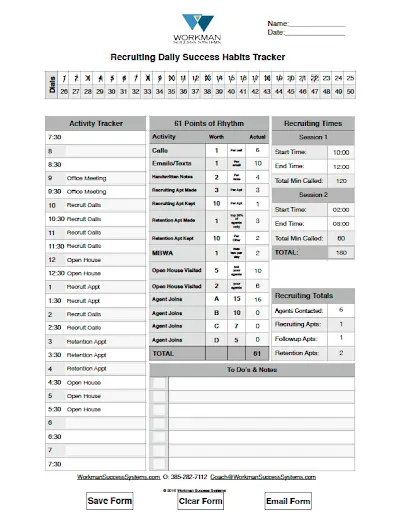
6. Streamline the recruiting and hiring process
In a competitive hiring market, candidates won’t wait around while you get your ducks in a role. Have someone dedicated to interviewing and moving candidates through the pipeline. When you’ve found an agent that’s qualified, offer them a contract right away.
7. Develop scripts
Develop scripts for sourcing and interviewing candidates. This will streamline the recruiting process and provide a better experience for agents. Create a list of common objections from potential agents and a response to each objection.
Ramp
Ultimately, the best recruiting strategy is agent success.
Getting agents to sell more and having more signs in yards is the best way to recruit more agents. Use a systemized onboarding and launch plan to set agents up for success. A comprehensive agent orientation day that walks the new agent through all of the systems and materials they need access to will help the agent get up to speed faster and feel supported. Verl recommends breaking every single item down into a spreadsheet with an assigned owner for each task.
Then, there should be a detailed 90-day ramp plan with specific tasks for the new agents, team leads and admins. The more detailed the plan, the easier it will be to automate onboarding new recruits.
Reward
Show new and current agents that you value their work and motivate them with regular encouragement and resources.
Celebrate success
Celebrate the activities that get results. Reward the number of calls made, demos set, contracts signed and net profitability. If an agent is struggling, look at their activities. Are they getting up every day and doing the things that will help them be successful?
Remove roadblocks
Cut down on time spent creating flyers by templatizing content (with a tool like Lucidpress) and giving it to agents, so they can get what they need and get back to selling.
Incentivize agent referrals
Current agents can be a powerful recruiting tool, so be sure to reward the agents that bring in new talent. A cash incentive, gift or charitable donation all work to recognize the additional value the agent is bringing to the brokerage.
Retain
Retention is key to maintaining a great network of agents. In fact, NAR has found that 30% of realtors have been at their current firm for one year or less. Verl recommends doing the following when developing an agent retention strategy.
Identify at-risk agents
If you have agents that have 10 transactions per year or less, provide them an environment where they can be more successful. Provide clear solutions such as a training center, templatized content for marketing, personal coaching for growth and partnerships.
Never do anything for new agents or recruits you don’t do for current agents
Find ways to engage with and show appreciation for your current agents from birthday cards to stopping by open houses to ongoing training. At the end of the day, ask agents what you can do to better support them.
Now that you’re equipped with the four R’s you’re ready to build a recruitment plan that will consistently bring in new recruits and retain your top talent.
Advancements in technology and the power of the internet have leveled the playing field for most, so the need for a creative & effective real estate branding strategy is more important than ever if you want to stand out from the crowd.
Related: The complete guide to real estate marketing
Consumers today are market-savvy, and it’s brand authenticity, social proof and genuine human connection that drive our purchasing decisions. We all want to buy from real estate brands we know, like and trust, and so the Person-to-Person (P2P) stance on marketing has never been more important.
Above all else, buyers value real estate brands they have confidence in, and that means delivering integrity, knowledge and strong communication.
While this suggests that real estate brokerages must leverage their real estate agents’ personal brands to win over buyers, the importance of a consistent, brokerage-wide branding approach cannot be ignored.
Without the support that a strong, dependable real estate brand offers its realtors, demonstrating integrity and knowledge becomes harder, and putting effective communication practices in place can be a challenge.
What is real estate branding?
Ultimately a brand is a summation of the feelings and experiences an individual associates with a real estate brokerage. Many components work together to create a real estate brand including visual components such as the brand font, colors and logo. Other important brand elements include your brokerage’s values, processes, reputation and unique value proposition.
How to build real estate brands for agents, not just clients
In real estate, your brand isn’t just for your clients or potential clients. It’s also for your real estate agents.
Think about it: if your brand is your story, then your agents have to see themselves as players in that brand story. Where you came from, who you serve, what you do well… All of these things are part of your brand story. Agents need to relate to this brand before they can see it as valuable and worth protecting. [ ] Are you telling them this brand story, and if so, is it resonating with them?
Of course, real estate agents also carry their own personal brands with them, which adds a new layer of complexity. If they can’t harmoniously combine their personal brand with the brokerage brand, it’s going to be very difficult to maintain brand compliance.
Not only will brand compliance suffer, but your retention rates might, too. If staying on-brand is too much work for your agents, they might leave for greener pastures. We heard a lot of concern about agents leaving one brokerage for another, especially independent brokerages whose agents switch to a national brokerage.
Our advice is to cultivate a real estate brand that is consistent but malleable. The core elements of your real estate brand should always remain the same, but in other areas, give your real estate agents the opportunity to add a personal touch.
This is one big reason why Lucidpress performs so well against “form-fill” software. Our templates support drag-and-drop design, so real estate agents can customize their own marketing materials. But we also provide template locking, so corporate designers can lock down logos, colors, fonts and other assets that make up a brand. It’s a win-win scenario: real estate agents can quickly and easily make marketing materials that they’re proud of, while designers can rest easy knowing the agency’s brand is protected.
In this way, it becomes much easier to tell your brand story—to buyers, to sellers, to partners, and crucially, to your real estate agents.
How to build real estate brands for clients
What about the other side of the equation—building real estate brands for clients? We’ve heard again and again that building a strong real estate brand is critical for success today. In particular, real estate agencies need a strong brand to:
- Hold their footing in the marketplace
- Stand out from their competitors
So it’s no surprise that real estate agencies and brokerages are looking for ways to stand out above the pack, and branding offers an effective way to accomplish just that.
National real estate brokerages usually have the advantage when it comes to brand awareness and legacy. Because many of them have been around for decades, they’ve achieved high visibility and built up good brand reputations. To preserve this goodwill, it’s vital for these companies to protect their brands from poor design and off-brand marketing.
On the other hand, independent, local brokerages might have a leg up here—because they’re small, they can adapt quickly. They also have the home-field advantage when it comes to fitting into the community and knowing the neighborhoods. All of this knowledge can be leveraged to create a recognizable, trustworthy real estate brand.
Key takeaway
Although real estate is more competitive than ever, it’s possible to pull ahead with a strong, consistent brand. When your branding is consistent, it’s easier to innovate and branch out to new technologies and business models without diluting your message. By building and telling a brand story that resonates with real estate agents and clients, your brokerage is laying the foundation for future success.
Real estate branding techniques
To balance the brokerage brand with the realtor’s personal brand, agencies need to develop a system for creating content at scale and storing it in a central hub that everyone can access.
Consistency is key in branding, but as the number of channels and mediums continues to grow, it’s becoming increasingly difficult for brokerages to manage.
With designers left fighting an overflow of requests and rogue real estate agents taking it upon themselves to create content, the quality of a brand and its message can quickly become diluted.
By taking a hands-on approach to producing top-level brand assets and distributing them well, you’re giving your agents the resources they need to develop a personal brand without breaking from the brokerage’s branding.
The real estate brokerages who do this well understand that branding & marketing departments need ultimate control when it comes to producing content, but giving agents the flexibility to adapt and personalize that content is the way forward.
By creating branded, templated designs (where a brand’s logo, slogan, colors & fonts are locked in, but text, photos & contact details can be changed), marketing directors can oversee brand consistency while also streamlining workflows.
The key is not only to create this central bank of branded content but to give agents both the training and the guidelines they need to use it effectively. To make it work, you’ll need to think long-term and be consistent.
Once your brokerage has implemented a process based on this principle, the next step is to look at how you can use content to establish and develop a strong brand.
Real estate branding & content ideas
Forward-thinking brokerages know that their digital spaces are much more than online brochures. Publishing photos of properties—however appealing—isn’t enough if you’re looking to play big.
To level-up and move past publishing only the expected collection of real estate listings, you’ll need to look for ways to add value, be informative and provide inspiration.
Upgrade your website & social channels by putting some of the following ideas into practice.
- Tell stories that put your target clients in the picture
More than just showing off the building or the rooms inside it, how can you help your buyers imagine themselves living or working there? What is it about the area, the facilities, the amenities or the community that will have a positive effect on their overall lifestyles or businesses?
Perhaps you could conduct interviews with existing residents or produce a feature on local restaurants, schools, and stores? The possibilities are endless; you just need to tap into the right audience and understand what makes them tick.
- Demonstrate your knowledge and give your buyers a head-start
Give your audience a reason to trust you by providing them with answers to the questions they have surrounding real estate.
The key here is to ensure you’re adding true value and not just pushing out sales messages disguised as advice. Put your real estate clients at the forefront of your mind when you’re creating this type of content, and again, try and get to the heart of who they are and what they want.
- Invest in video and photography
The National Association of Realtors found that 85% of buyers and sellers prefer to work with an agent who offers video marketing, but only 15% of agents actually use video to market their listings.
In today’s digital-first landscape, where posts containing imagery and video gain the most traction online, embracing new media is essential for brand survival.
- Bring in your forward-thinkers
As well as looking for ways to support your agents in building personal connections, you should also find opportunities to have them contribute to the company’s brand.
Engage your best real estate agents and bring them onboard with the content creation process. Put them in front of the camera for a Q&A or discussion, then broadcast it live or record it and use it across your platforms.
In summary, if you want to build a respected, trusted and engaging real estaee brand, remember to:
- Be inspirational
- Be informative
- Add value
Common real estate branding mistakes
Building a recognizable real estate brand your clients can connect to is one of the most important things you can do for your business. Everyone knows you should be unique and offer great service, but many brands start off by making the same mistakes.
To help you start your real estate branding journey on the right foot, here are a few common missteps and how to avoid them.
1. Not having an authentic brand identity
Authenticity means staying true to a brand’s essence. Without this kind of transparency, your brand might seem untrustworthy (or even too cookie-cutter) for customers to pay attention to.
The first step towards learning how to build brand authenticity is to answer the following questions, which will help you better envision your brand’s identity. Then, take all those notes and find ways to put them into an actionable plan.
Questions to ask yourself:
- Who are you, what do you do, and why do you do it? Tell your story and the story of your brand.
- What’s your vision? Your passion? You do not want to lose sight of your goals. Potential real estate clients will respect and follow you because you stick to your guns.
- What do you believe in? What are the core values driving your real estate business? If your brand had a tagline, what would it be?
2. Not using the full power of the internet
Because so many consumers shop online these days, it’s easy for them to imagine finding their realtor or their next home the same way. Phones, tablets, laptops—these are our new shopping malls. If you’re not harnessing the far-reaching power of the ‘net (such as social media), then it’s safe to say that you’re missing an entire sector of the market.
There is good news, though: It’s not too late to jump in and reap the benefits of digital brand-building. If you’re a newcomer to the scene, here are the most impactful ways to get started.
Videos for real estate
People are very visual when it comes to shopping around for a purchase. Clients want to see what a real estate listing looks likes.
Videos that demonstrate the value of your service can be invaluable to building your overall brand. Periscope and Meerkat are two video-creation apps that stream your videos right to Twitter. (You can use a smartphone to record a YouTube video, but you can’t edit or make it look more professional without video-editing software.)
Perhaps you’ll decide to hire a video production company to assist you in creating your videos. For example, you might want to create video walk-throughs of all your properties to show prospective buyers what they have to offer. A company with extensive experience filming apartments, homes & offices will know how to make your property look great on video.
Instagram for real estate
If you use Instagram for social purposes, then you already know how powerful it can be for brand marketing. This strategy is common among influencers, and for good reason. Instagram images can demonstrate and advertise your brand’s products & services, but they’re also the perfect place to show off your brand’s philosophy and personality.
Because of its unique visual format, it’s important to create content specially for Instagram. A few quick snippets will only take a few minutes of your day to make, so make sure to update this platform regularly and keep your followers engaged.
Facebook for real estate
Creating a Facebook business page or group is a popular starting place for social media marketing. It’s a reliable way to ask questions and provide customer support, and it creates a sense of community among your followers.
How can you tailor Facebook to real estate branding? Offer first looks at new properties, exclusive discounts, and valuable industry info that will encourage newcomers to follow you. Remember to be visual here, as well: posts with photo or video attached outperform those without.
3. Not building your real estate brand luxuriously
Choosing the right colors, design elements, logos, typography—everything matters if you want to create a luxury brand that represents quality and credibility. But, here’s something that might surprise you: You can create a luxurious brand on a smaller budget than you think. That is, as long as you’re thoughtful and deliberate about what you’re building.
Your brand identity should harmonize with your brand’s essence. (Remember authenticity?) It all works together to communicate your mission, your passion, and your unique selling points. Start with your brand values and work towards a logo that represents them well. As you add in new elements, like colors & fonts, make sure they all work together to send a clear, professional message about the quality of your brand.
Finally, remember that your clients can be some of your best brand ambassadors. They know what it’s like to work with you, and their story can inspire others to do the same. Collect testimonials from your satisfied clients and from other real estate professionals. (Pro tip: Consider recording them as video testimonials.) From there, you can post them on your website and social media channels.
4. No genuine connection with others
According to Harvard Business professor Mikolaj Jan Piskorski, social media is one of the best ways to build connections to your target market. However, it’s not just about being present—it’s about finding ways to spark genuine human connection.
This could mean publicly supporting a cause that reflects your brand’s values and that others will want to support with you. Another idea is posting original, behind-the-scenes content that helps your audience to get to know you and your brand. There are lots of things you can do and new ideas to try.
The point is, by genuinely connecting with your followers, you create positive brand experiences that aren’t just about making a profit. Instead, you’re putting yourself out there as a real estate brand that wants to help others and to serve your community in a positive way.
5. Not going after free press
Did you know you can jumpstart your brand awareness with local media? Make yourself available for interviews in specialty newspapers, magazines and podcasts. You can easily create a stellar one-sheet bio in Lucidpress to share with interviewers, so they understand your areas of expertise and how you can demonstrate them for their audience. This can be a great low-cost way to start building a name for yourself.
Lastly, don’t forget that you can amplify your own expertise as well. Create and curate content that your audience will want to read and share. You can do this with a blog and with your favorite social media networks, like Instagram or Pinterest. It doesn’t all have to be your own content—discovering and sharing others’ content can help you establish a presence and build new relationships. Just make sure you share thoughtfully and give the author credit.
Key takeaway
Don’t get trapped in the same pitfalls other real estate brands have fallen into. Master these principles so you can think outside the box, make real connections, and breathe life into your brand’s unique philosophy.
Examples of quality real estate branding
The real estate industry boasts many great examples of recognizable brands. In fact, a Lucidpress survey found that a large majority of the average consumer recognizes the top real estate brands.
- 84% of consumers correctly identified Berkshire Hathaway by its font alone.
- 91% of consumers correctly identified Coldwell Banker by its color scheme.
- 90% of consumers correctly identified RE/Max’s imagery (colors and balloons), but without that imagery, only 63% could correctly identify its font.
- 81% of consumers correctly identified Keller Williams by its color scheme
Re/Max Rebrand
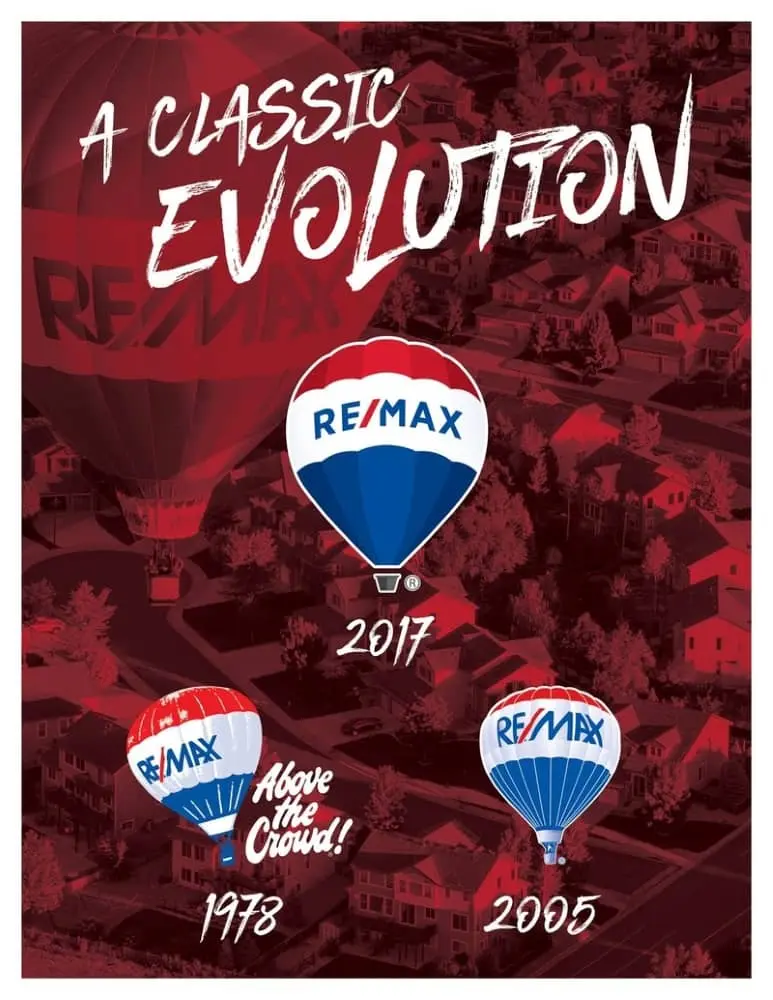
Rebranding is risky business. There’s so many ways for it to go wrong, and we’ve all seen it happen — Tropicana without the orange and Gap with its one pixel of color. (Here at Lucidpress, these make for great lunch table discussions on brand consistency.) But sometimes a gentle refresh propels a brand into the next couple generations.
Before 2017, RE/MAX hadn’t seen a change to its branding in over 40 years. A new logo was in order, one that looked cleaner on a digital screen and represented a modern brand trusted by today’s buyers. Before even going to the drawing table, the brand sent out developers to research what it was about the old brand that made it so iconic and trusted. There’s no sense starting from scratch when certain elements of a brand keep the customers coming back.
The developers took to the streets and surveyed over 20,000 people. They found three “fan-favorite” elements: the “red on white on blue” color scheme, the famous slash between syllables and the all-caps wordmark.
Backed by consumer research, RE/MAX fearlessly took to the drawing table to refresh its brand design. Anchored by the elements that proved to work already and inspired by modern design, it brought to life its new balloon that is more conducive to digital marketing and online shopping.
Cabo Cribs Logo
If you’re looking to buy property in Cabo, I’ll bet Cabo Cribs’ logo catches your attention.
The logo design is simplistic, but it doesn’t scrimp on the essentials of a good logo. It’s easy to understand, elegant, and has a small graphic that makes it obvious they’re selling homes.

Branding, and especially brand consistency, is important to us here at Lucidpress, and we’ve put a lot of effort into understanding how that resonates with real estate businesses.
To learn more from us and some of the first-rate agencies we’ve been lucky enough to partner with, check out the following resources for tips.
- How Chestnut Park’s managing graphic designer used Lucidpress templates to elevate the brand, reduce design turnaround times, streamline communication and retain agents.
- Should you hire a real estate marketing agency? – We asked real estate branding experts how to identify the right time to hire an agency and what you should be looking out for when you do.
- Guide to real estate marketing automation — Does the term “marketing automation” make your eyes glaze over in boredom? We break down this powerful concept in plain English, so you can decide if marketing automation software is right for your brokerage.
Learn how to elevate your brand and ensure consistency with this free guide to real estate branding.
The real estate industry boasts some of the most iconic brands: Re/Max, Berkshire Hathaway and Coldwell Banker to name a few. But how recognizable are those brands’ logos to the general consumer? And does it match real estate professionals’ views of the industry’s branding? That’s what we sought to find out in our latest two surveys.
We quizzed 395 people on their recall of well-known industry brands and followed up with a survey of 36 real estate professionals to get their thoughts on the industry.
Executive summary
When it comes to real estate professionals, they value their brand’s position within the industry. They ranked positioning as the most important branding element of a real estate company’s success, closely followed by user experience on the app or website.
Only 11% of real estate professionals said the logo was the most important branding element for their company’s success.
When it comes to consumers, logos are crucial for brand recognition. The majority of respondents were able to correctly identify top real estate brands like Coldwell Banker, Keller Williams, Berkshire Hathaway and RE/Max by their logo alone. However, some elements of the logo were more identifiable than others:
- 84% of consumers correctly identified Berkshire Hathaway by its font alone.
- 91% of consumers correctly identified Coldwell Banker by its color scheme.
- 90% of consumers correctly identified RE/Max’s imagery (colors and balloons), but without that imagery, only 63% could correctly identify its font.
- 81% of consumers correctly identified Keller Williams by its color scheme.
- Only 30% of consumers could correctly identify Century 21’s current logo due to confusion over a recent rebrand.
Century 21’s recent rebrand didn’t just throw off consumers. The majority (56%) of real estate professionals also did not think the rebrand was successful and expected consumers to be confused. The real estate professionals were also right about how well consumers know and can recognize these top brands: 84% of professionals believed consumers could recognize top real estate brands very well at a glance.
Here are how the top brands ranked in order of most to least recognizable
- Coldwell Banker was the most recognizable brand with 91% correct answers.
- Re/Max was the next most recognized for its trademark at 90%.
- Berkshire Hathaway took the third spot, with 84% of consumers recognizing its font.
- Keller Williams came in fourth, with 81% correctly identifying it by color scheme.
- Century 21 was last due to confusion over the new logo, with only 30% of consumers identifying it correctly.
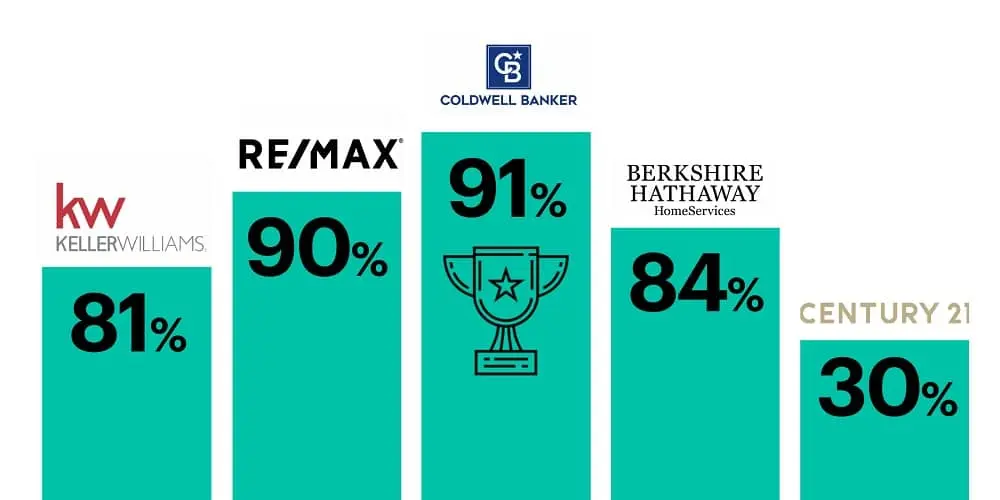
Breakdown of consumer quiz results
Consumers were presented with several variations of a brand’s logo, font or imagery and asked to identify the correct one. Results are displayed below with a green checkmark identifying the correct answer.
Question 1:
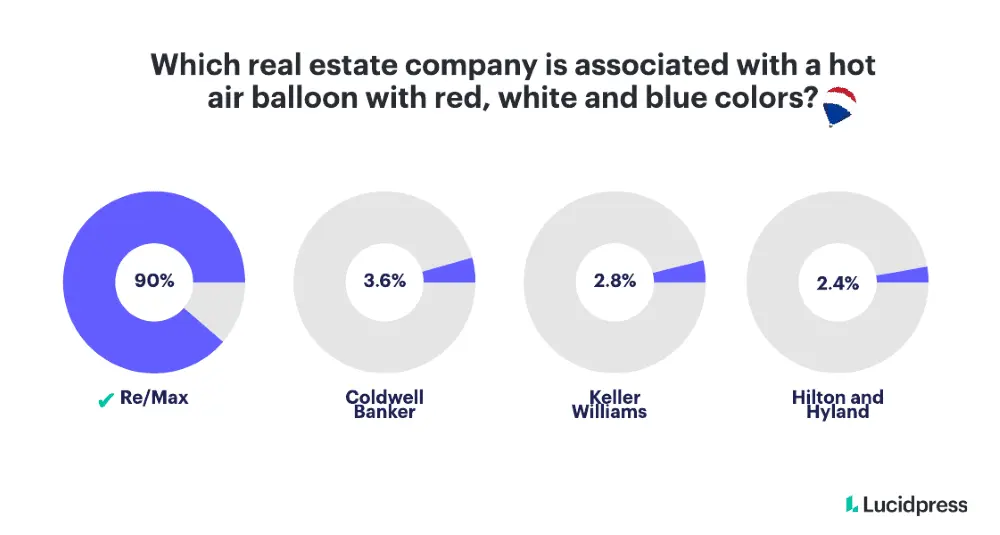
Question 2:
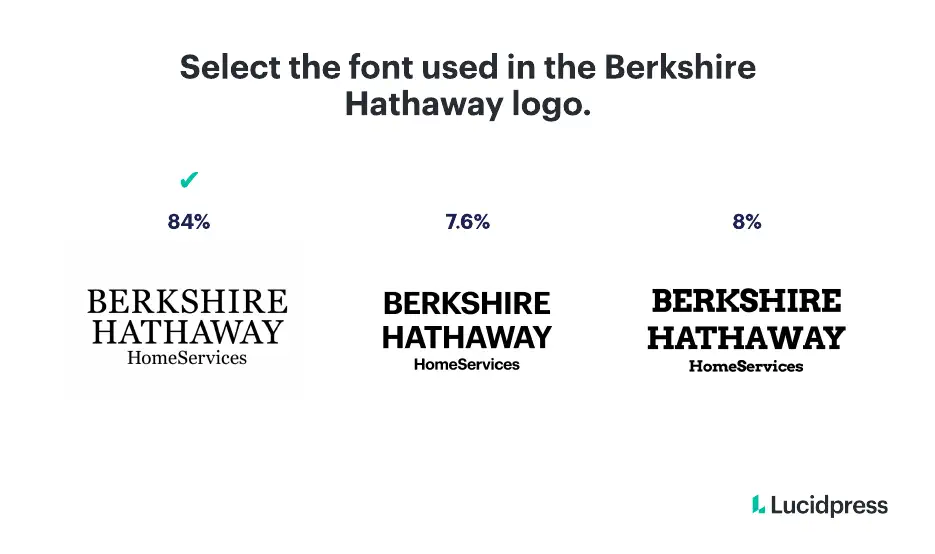
Question 3:
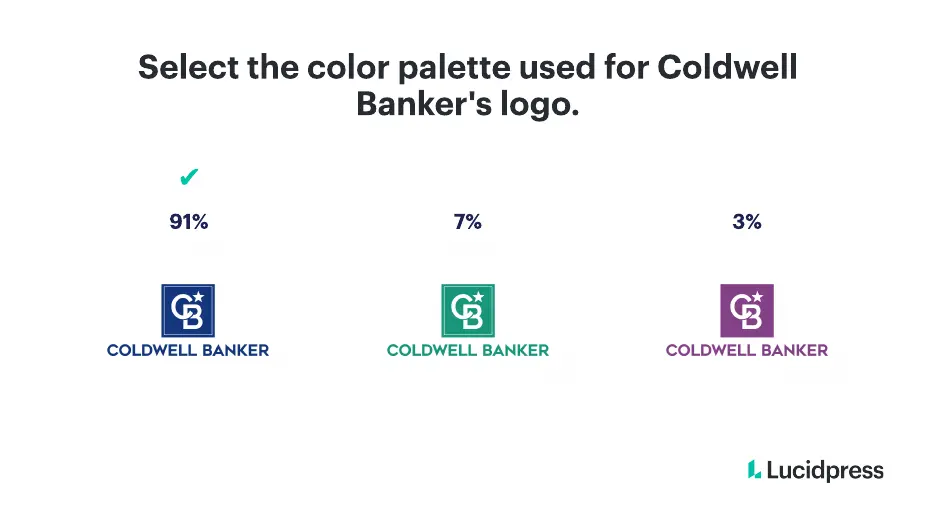
Question 4:
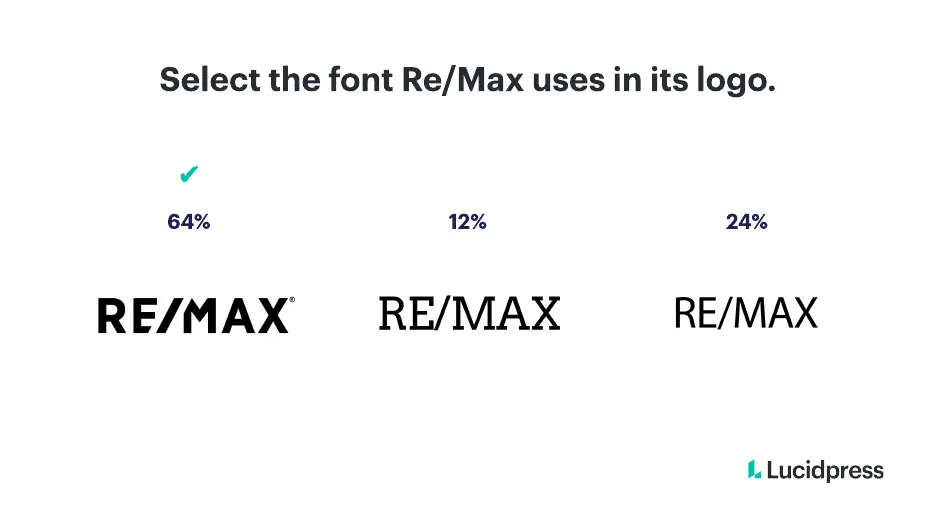
Question 5:
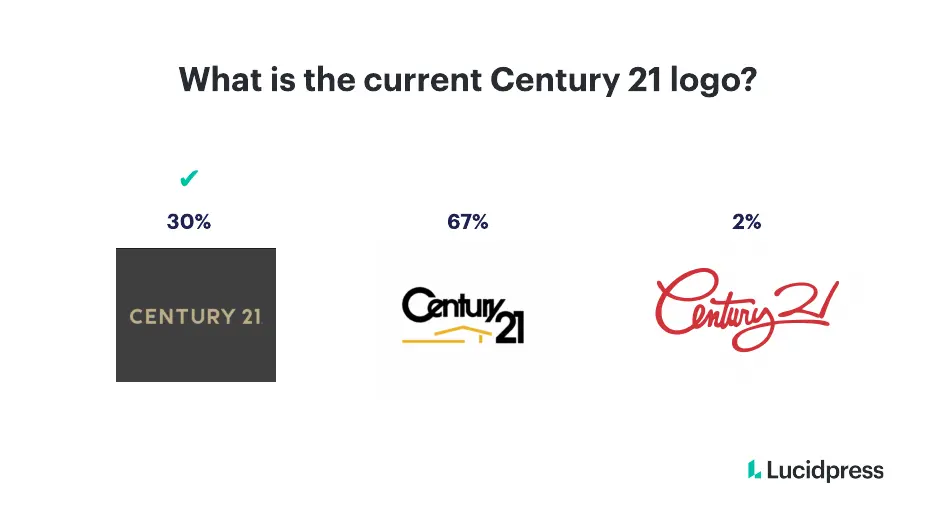
Question 6:
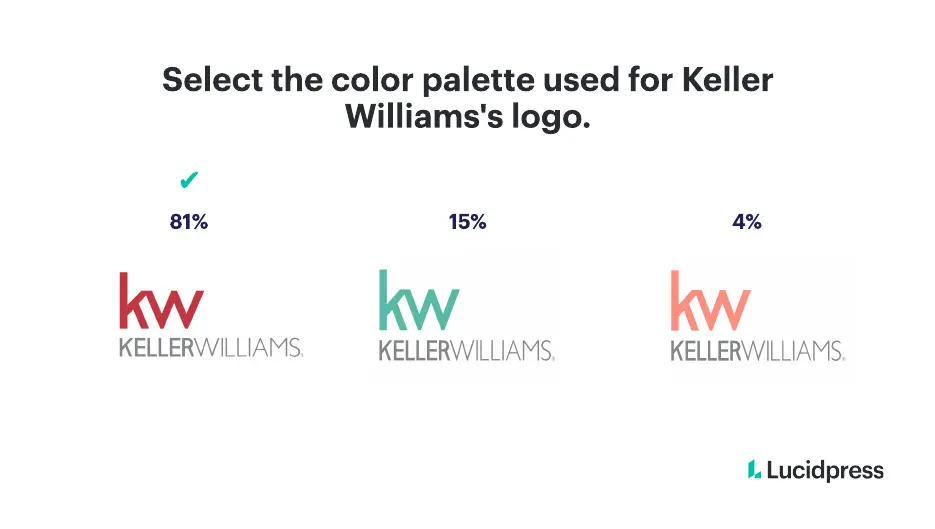
Breakdown of real estate survey
This survey was distributed to real estate professionals. 45% of respondents identified themselves as realtors or real estate agents, 38% identified themselves as marketing or creative professionals in the real estate industry and 16% had another role in the real estate industry.
Question 1:
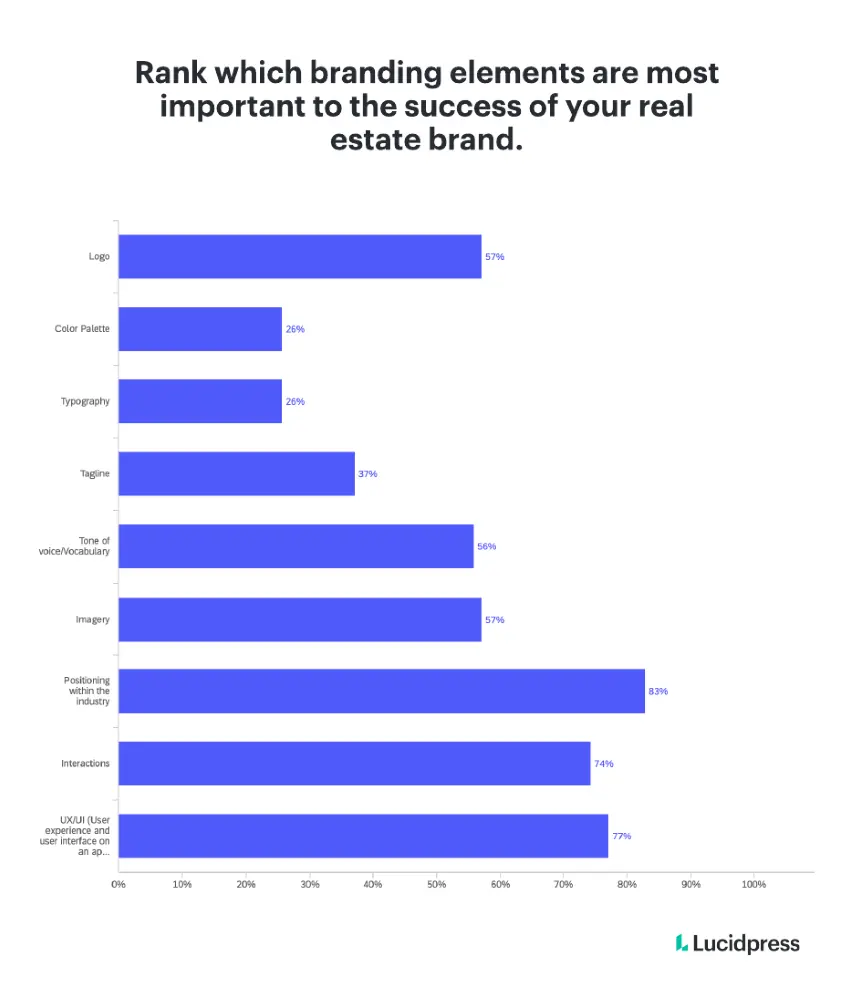
Question 2:
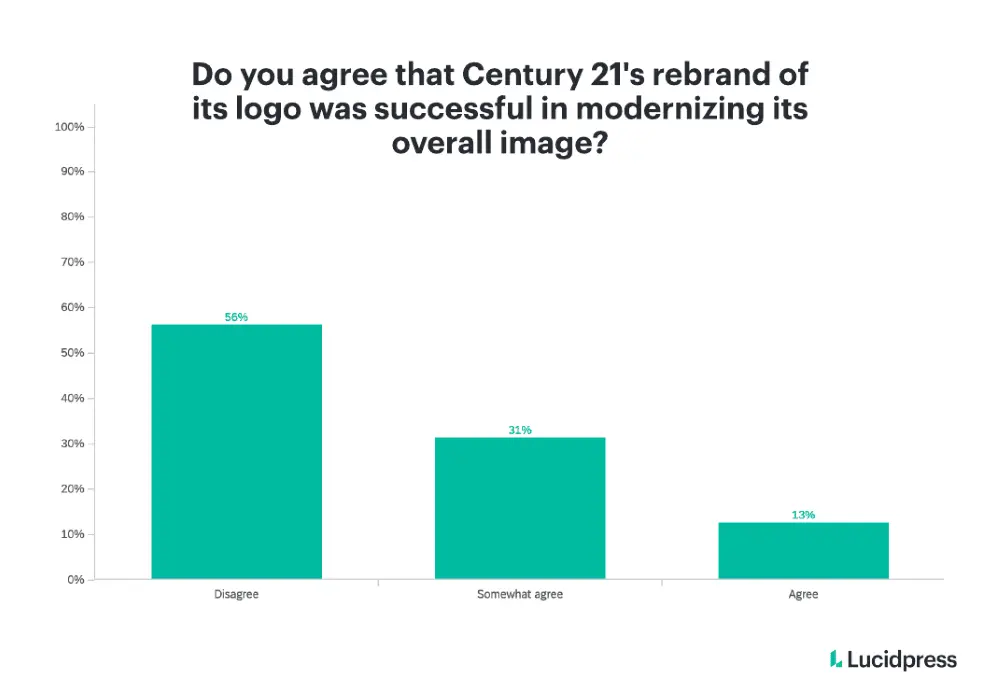
Question 3:
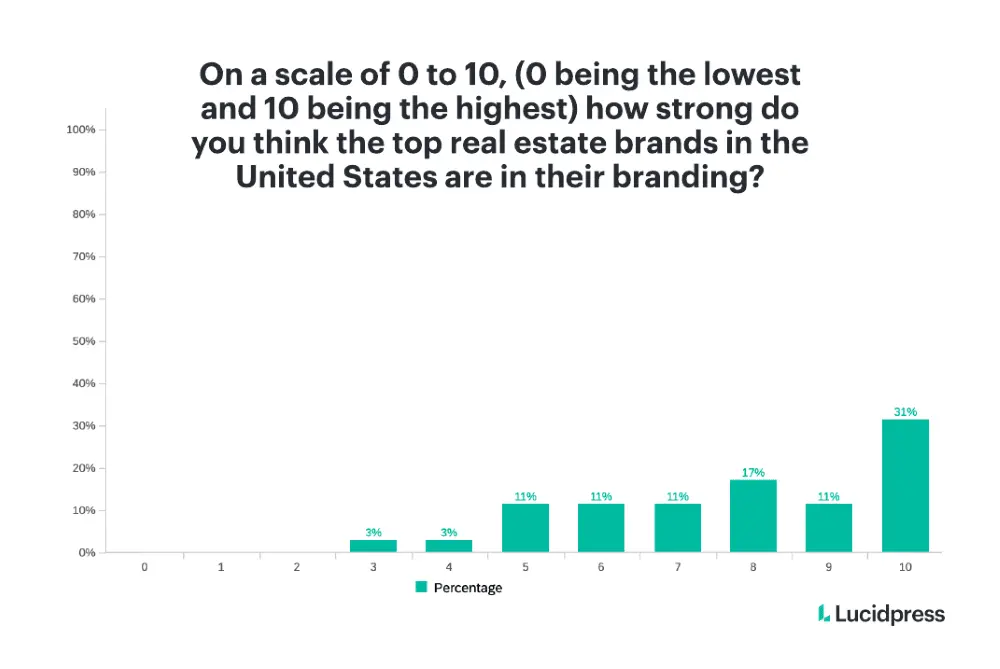
Interested in real estate branding? Learn more from our real estate branding guide or our comprehensive real estate marketing guide.